#Back in the late 2000s and early 2010s when I was young and not almost thirty and Burdened By Life that is.
Explore tagged Tumblr posts
Text
I’ve spent the better part of an hour going through old Hetalia tags, being unexpectedly sad that my two favourite tags are so dead, and rummaging around my old, half-finished (and nearly-finished) WIPs to see if there’s something I can complete and maybe post one of these days.
#Unexpected Nostalgia#And of course I'm always in a history mood.#But still... Those two ships were such a big part of my life for over ten years#I miss them. I miss the spark I used to have for writing#Back in the late 2000s and early 2010s when I was young and not almost thirty and Burdened By Life that is.#The bills won't pay themselves#But at least I only have to struggle with them for another month#text#chey.txt
9 notes
·
View notes
Text
I've watched a few interviews with the cast and crew of Good Omens and can I just say that, as someone who was a BBC's Sherlock fan back when it was still airing, it makes me so incredibly happy to finally have a show that not only doesn't queerbait (yes, the bar is in hell), but where the actors seem genuinely happy with and open about the queer direction the show is going in, and where they don't shame the fans for also being happy about this development. I just watched an interview with Michael Sheen where he, almost unprompted, brought up fanfiction and said that he thinks that it's a shame that people used to be weird about fanfiction because he thinks it's amazing and shows a love for the show. And... as someone who kind of still gets upset whenever I'm reminded of certain interviews and panels with the cast and crew of Sherlock (if you were in the fandom I'm sure you know which ones I'm talking about), this unabashed celebration of queer joy from the cast and crew of a big show like this is just something I could never have imagined as a young, queer fan!
I get that there are different circumstances, Sherlock fans could definitely be a lot sometimes, and maybe it's cruel of me to compare shows like this. But I genuinely believe that Sherlock did some actual damage to my (and many others') trust in media and in creators. It's one of the main reasons I absolutely didn't believe Our Flag Means Death would do what it did even when I was seeing it play out before my very eyes. It's why I didn't believe Crowley and Aziraphale would ever even come close to actually expressing their feelings for one another despite all of the queer subtext in season 1 and despite the cast and crew calling it a love story. Maybe all of this even added to my suspicions that they weren't going to follow through because we've all been let down time and time again.
And I'm not trying to pin the fault of queerbaiting solely on Sherlock and the team behind it - I am aware that there were many other big shows and movies that also queerbaited at the time. But out of all of those shows, I mainly watched Sherlock and it, along with the interviews with the cast and crew, were my main points of reference for what to expect regarding queer representation in (especially mainstream) media at the time. Which is why I'm mainly using Sherlock as an example of this unfortunate trend.
I guess what I'm trying to say is that with all of these shows now subverting our very, very low expectations for what kind of space queer characters and queer stories are allowed to occupy in (especially mainstream) media, I feel like my teenage self is starting to heal just a bit. But, both back then and in hindsight, I'm also completely baffled that a few shows in the late 2000s and early 2010s were able to get away with the shit they were pulling and completely ruin young, queer fans' trust in both creators and in their own media literacy.
#good omens#good omens season 2#go2#good omens spoilers#good omens season 2 spoilers#go2 spoilers#bbc sherlock#sherlock#our flag means death#ofmd#our flag means death spoilers#ofmd spoilers#queerbaiting#queerbait#fan culture#fanfiction#fanfic#fandom
776 notes
·
View notes
Text
what happened to high school?
When I was young, I thought high school students were so cool and grown up. I watched as they started driving, dating, having sex, and going to parties and I couldn't wait to be that fun age. Now that I am in high school, where has the fun gone?
As people have realized, generations are starting to look younger and younger. When you imagine a senior in high school, you often don't imagine the people that I go to school with. Their baby faces haven't gone away and the growth spurts have not hit yet. Part of the appeal of high school is the feeling of adulthood and maturity, not only in the classes you take or your social endeavors, but in the way you look. I don't know if it's because there isn't as much of an age gap between myself and a senior in high school now, but when I was little, they just looked so old. I don't see that anymore.
Also, technology is nowhere near new and exciting. It's a part of our everyday lives and I will resent that for the rest of my life. While it comes in handy for teaching and grading, and Google is a major plus, it shouldn't be our only source of school these days. I rarely get assignments on paper and honestly, I wish they were. I want physical copies and mementos from my high school days. Not to mention, I don't even have a real school identification card. It's in an app.
When social media and technology was new and exciting, it acted as a third space for teenagers. Like malls and roller rinks in the eighties and nineties, Tik Tok, Instagram and Tumblr are the "hang-out spots" for teenagers in the late 2010s and 2020s. In the early to mid-2010s, teenagers still went to malls and roller rinks to hang with friends while also adjusting to the new online world. It was a place for teenagers to communicate their ideas and express themselves. Now it has become a part of everything. I almost never have conversations where someone doesn't whip out their phone mid sentence
Also, we have no defining trends for our generation. Social media has brought forth something called the microtrend. A song, make-up look or body type will be a trend for two weeks before out short-attention spanned peers decide it's not interesting or cool anymore and move on to something else. While the nineties had grunge and glamor and the eighties had acid wash denim and big hair, the 20s has....leggings? And Utah curls? What I mean is, when you think of the 1990s, a specific image comes to mind. Grunge music and dark eye make-up. When you think of the eighties you picture big curly hair and neon spandex. When you think of the 2020s, nothing in specific comes to mind because we can't decide on one thing. Nothing is interesting or cool enough anymore. We live in such a capitalist, consumerist society that once we engage in something too much, it becomes boring and we have to find something else. Social media and influencers only amplify that. I don't know if it's Gen-Z's push-back on being categorized or defined by anything, or if nothing is good enough anymore.
And don't even get me started on the music. In the 20th-century, different music trends came and went. In the 70s hair metal and power ballads became huge. In the 80s glam metal, synth, and pop started to materialize and in the 90s alternative rock, grunge, nu metal, and boy-bands made their breakthrough. This overbearing control of the music industry made music a novelty and allowed teenagers to be a part of a subculture. When punk came about in the 70s and goth in the 70s and 80s, it allowed teenagers to interact with another and create relationships because of the subculture they identified with. This made high school the stereotypical version we see in 90s and early-2000s movies. The goths sit over here and the popular kids sit over there. Even in the 90s with grunge and the 2000s with emo. Though to come it seemed “clique-y��, it made making friends and self-expression more cohesive and less stand-out. Even into the early 2010s, those who liked pop punk, didn’t hangout with the kids who like mainstream pop or trap beats.
With the rise of the influencer and easy access to higher paying or earning jobs, anybody can make music, even if they’re horrible at it. Content creators online put out singles or albums that sample the same beats as everybody else and have the same dense and shallow lyrics, where it is obvious they’re trying to sound deep and meaningful but they’re fully missing the mark. It’s hard to want to claim a genre or use a specific sound or style of music to identify your generation or simply the people you hangout with. New music doesn’t have that power anymore. New major music genres have not been pioneered since the 90s with grunge and nu metal. People that are making music aren’t creative and the creatives aren’t making music.
The things people listen to and the way that they dress says a lot about them. For teenagers, it has said everything about them. However in the last ten years, social media and technology has ripped those ideals away from us. Nobody wants to be perceived as one thing. They want to be everything and nothing is good enough to define anybody anymore. Tik Tok has ruined the essence and the glowing aura that once was the teenager.
#high school#school#student#academics#social media#social skills#tech#trends#hell is a teenage girl#teenagers#technology#2000s emo#gothic#pop music#artists on tumblr#trap#hip hop#nu metal#grunge#90s#80s#70s#2000s#2010s
13 notes
·
View notes
Text
I... Think I'm experiencing one of those moments of wistful nostalgia that leads to the road of constantly missing and wishing for "the good ol' days," even though I know that line of thinking is what leads to a lot of the "look at how great the US was before black people could vote! Hell, before women could vote!!" nonsense conservative reactionaries spout, but... There's just something weird about feeling something and not realizing what it is until you've almost gone through it completely. Especially since there's this weird sense of mourning tied to it, which you'll understand in a bit if you choose to read on. I'll put a full explanation of what I mean below the cut so my nonsense rambling won't fuck with your tumblr scrolling. CW, I'm going to be talking about Rooster Teeth, which involves some of the controversies that came up towards the end of its lifespan, so if that stuff (including discussions of homophobia, grooming, and abuses of power for sexual favors) triggers your trauma response and/or you were a victim of certain parties who were fired from the company for good reason in the last few years of RT (if you know, you know, and if you don't, well I'll get into it under the cut), feel free to skip this for your own safety.
So, I was a Rooster Teeth fan in one way or another for a very long time. I first watched Red vs. Blue when I was, admittedly, far too young to do so (I was born in 2000, and I was watching it on YouTube on the first iPod touch I owned that had the YouTube app back when the icon for YouTube was still meant to look like an old CRT TV... Yeah, far too young for that show lmao), around 2010-ish got into Achievement Hunter thanks to the Halo Reach Fails of the Weak series, which lead to their Minecraft series, then I had a massive hyperfixation on RWBY (though I didn't realize it was a hyperfixation due to being very uneducated on the ADHD I knew I had because I was a kid, was scared out of agreeing to get medicated by my mother when I was diagnosed at around 6-7 years old if I'm remembering the time frame correctly, and was taught the idea that you "grow out of" being neurodivergent) for the first 4-5 seasons or so. I was even a Rooster Teeth FIRST member for years when I started working.
Now, obviously, I took a bit of a step back from watching them around 2020 or so when the controversy around Ryan Haywood being a grooming creep who allegedly succeeded at having physical relations with minors (while married with kids btw) using the power dynamic of them being AH fans as an entry point to conversation and a way to coerce them came to light - and I ended up staying with watching RT in general, though I was far more into Achievement Hunter in particular at the time, because I felt they had shown that the people around Ryan didn't know he was a piece of shit and genuinely felt disgusted, betrayed, and overall appalled at what they learned about him. I also ended up maintaining my FIRST subscription, which was yearly anyway so I couldn't have really paused it at the time since they already had my money, but I decided to stay with supporting them because I liked the content and getting the early videos, exclusive series, and other stuff through the app and website.
Fast forward to late 2022. Now, at this time, I was dealing with the massively first-world problem of liking the content RT was producing, though not as much as I used to because things had changed a lot and I missed a lot of the "IRL fucking around in our offices" stuff that seemed to have gone completely by the wayside by that point, but I was also up-to-date on all of the stuff on their site that I cared about watching and so I started watching more stuff on YouTube again since, once I had started paying for FIRST, I had basically made RT into my primary content source to get my money's worth out of it. I listened to a lot of the podcasts that were kinda branched out from the AH space, such as Off Topic, Face Jam, and F**kFace (no, I'm not self-censoring, that is how the name of that podcast was stylized), the exclusive stuff related to those shows offered through the subscription, basically all AH content, and more.
I was basically current with all of it, because earlier in 2020 I was kinda in friend-group-limbo, where I was finally trying to find groups of friends away from just being in groups that I was introduced to by my sister where everyone just knew me as her younger sibling, and it was only around early 2022 that I actually started getting into the consistent friend groups I have now that I would consider some of the people I'm closest to in my life, including the group that I met my boyfriend in - partially thanks to a somewhat-depression-fuelled obsession with Destiny 2 that started shortly after the release of the expansion The Witch Queen. Due to my mostly-friendless life before then, not really knowing anyone IRL outside of family, the one friend group I thought I'd be able to stay in (a FFXIV FC I stumbled my way into) turning out to be fairly transphobic leading to me just straight-up ghosting them and quitting that game, and all of this being around the time that I finally quit League of Legends - which was both a toxic presence in my life that I was no longer enjoying but was also the main avenue I had for meeting and hanging out with friends - I ended up spending most of my free time thanks to the pandemic on a few, specific things. Those being 1) Zelda BotW on the Switch I purchased with my first-ever tax return since I had only started working in 2019, 2) my mostly fruitless-at-the-time pursuit of finding people who actually liked and knew me for me, not just my association with my sister, and 3) watching lots, and I mean LOTS, of videos on Rooster Teeth.
Seriously, through both of my failed attempts to go to college, the COVID-19 lockdowns, multiple personal events that led to me being pushed out of former friend groups not-so-subtly by my sister as I was trying to be a part of her groups a lot thanks to me not really knowing how to find people to interact with IRL or online for a variety of reasons, losing multiple good jobs that paid me much more than I get at this shitty retail job thanks to my own inability to handle having a full-time job without being constantly late to shifts and shit (seriously, working full-time hours makes me feel like absolute shit and I don't know if I'd ever be able to actually handle going back to a full-time job, which is why I really want to try and set things up to start streaming and turn that into something to supplement my part-time work enough to be able to live off of it and get away from my mother who is... not great), and multiple short-lived relationships that I still mourned over fairly heavily (to be fair, I had figured out I was pansexual, but I only realized in the past couple of months thanks to my BF that I'm demiromantic... plus I just didn't find any potential partners who understood my troubles with not being able to constantly message back and forth 24/7)... Watching a bunch of Rooster Teeth content was my comfort space, even when I didn't actually have my own space due to cramped living conditions for about a year at one point. It was what greeted me at the end of a long day of work, what got a chuckle or two out of me at my most depressed, what really defined (to me) some of the humor I love to this day of just friends fucking around and doing bits, I could forget some of the serious shit in the world that was going on for just a short time with the nonsensical stuff that just went into straight-up weird territory that really started rearing its head with the Morning Show Show (but was very visible with stuff like Last Laugh), and more. So I watched it all, voraciously, insatiably. I was caught up on everything until early 2022, when I started getting into Destiny 2 and actually, y'know, having friends again, so I missed a video here or there I'd catch up on later, usually as something to listen to as I went to sleep.
Then Kdin Jenzen made her post detailing all of the horrifically homophobic and transphobic bullshit she dealt with during her time working there, none of which I knew about because it had happened during times I was either too young to fully remember or during times I wasn't really watching RT. A "nickname" used for years (during which time people knew she was queer, btw, though she hadn't come out as trans yet and idk if even she realized that specific detail at the time) that was born from the f-slur. Horrific crunch that basically everyone in the company was subject to, constantly, which didn't change even after she was hospitalized with fucking pneumonia. She wasn't getting credited for videos she worked on. Then, she came out as trans, and the treatment got worse, where she'd deal with the same levels of overwork and crunch time while getting isolated off in a corner to do her work because "people had no idea how to deal with a trans woman," only there to do far too much work while simultaneously getting pulled out like a trophy as if to say "See? We're inclusive!!!" despite her horrible treatment and isolation.
In short, even though there were "a handful of good people" as she put it (with who being apparent by who she gave positive responses to at the time when they publicly apologized for their past behavior - some noting they had done so privately in the past and felt a public apology was still in order - with others being given rather harsh ones, including Geoff Ramsey, a founder whom she called out for never using the power he had as a founder of the company and as someone very high up in the company to do anything to stop the bullshit she and so many others dealt with at RT over the years), the company itself was absolute dogshit. So, I did what anyone should do in that situation - I felt absolutely sick to my stomach because I felt as if I, a queer person, had been duped for years on end by an inclusive PR image, set my FIRST subscription to never renew again, couldn't even stomach watching what they released during the time I could still watch ad-free until my subscription expired, pulled all of my RT merch out of my closet (all of which I ended up donating to a local Goodwill except for one shirt, though there's another one I regret getting rid of now), and proceeded to unfollow a lot of the RT people I had been following for years at that point en masse, with the exceptions of those Kdin personally responded well to.
Fast forward to now. I'm going to assume we all know that Rooster Teeth started the process of being fully shut down by Warner Media earlier this year, partially due to low revenue, partially because I don't think Warner could stomach having anything media-related they own have content anywhere that wasn't on HBO Max. As of now, the website is basically fully non-functioning, with just a farewell video and a simple goodbye message iirc. The only way to get many videos that were FIRST-member exclusive over the years is via the Internet Archive, and with recent rulings, that may very well be in jeopardy if the people who end up with the various RT IPs decide to have them pulled for one reason or another. Yet, because of a tangent in a conversation I had with my boyfriend after playing some Warframe, I started wondering what had happened to the various people and channels I used to follow...
So I went down a bit of a rabbit hole. I'm even following some of the ones that were decent people at a bad company that have gone independent, sometimes buying the old RT IPs they were associated with, now... but something just feels off. I felt empty. And now... I realize what's going on. I'm feeling this sense of nostalgia for a specific period of time in the history of Rooster Teeth's content production, during which I may have been at one of the lowest points of my life, but those videos were a massive source of solace during. I'm also grieving over the loss of a fucking company that I didn't even really care about anymore, but in some part of my mind I kind of did because of how formative some of the videos it produced were to me. I'm watching the post-mortem of a company that helped define so much of what we know as the modern internet thanks to its start as one of the last vestiges of the old internet before everything became overly monetized and corporate, for better or for worse - months after everyone else that still cared has already processed it.
I'm grieving over the final, 100% irreversible end of one of the last things that - again, for better or for worse - was a constant source of being able to see something new that fit within formats I was used to seeing since I was a kid.
If I wanted to see an actual let's play that had more than the bare minimum of editing done for a VoD that isn't just constant, over-the-top bullshit, had actual interaction between the people in it that showed they were at least work friends, that had all of the POVs in one video instead of needing to hop to 17 different VoD channels to see everything... Those videos were what I would turn to, more often than not. Like I said, new videos but in formats I loved. Now... even though I haven't watched anything like the old AH videos in almost 2 years since Kdin's post, I'm feeling this... Gap. A void. If I want to watch gameplay, chances are it'll be a VoD of someone I like watching, yes, but something like that lightning-in-a-bottle of the old AH stuff where everyone was in a room together and you didn't have to watch multiple VoDs to see everything you wanted to see... I genuinely don't know if that really exists anywhere anymore.
And thus, I grieve a part of my childhood and young adulthood that is gone forever. Sure, I can buy an external SSD and put copies of all of the old videos I liked on there for me to watch whenever I want, such as RvB or a bunch of the old AH stuff (I could probably even find the FIRST stuff that was never on YouTube if I really tried), it doesn't change the fact that, though some vestiges of what once was will live on through different podcasts and channels made by the few decent people that were left in the ashes of the dumpster fire that was Rooster Teeth, new stuff made like that is, quite possibly, gone forever unless someone were to get enough money scraped together to be able to try and do something like it again - and it's unlikely it'd make enough back to be around for long in the modern age of content creation and consumption. Hell, to my (fairly limited, admittedly) knowledge, even before RT was shut down, the main channel they owned that I'm nostalgic for now was essentially shut down - Achievement Hunter was retired and the people that remained made something called DogBark.
It's a part of the unending march of time - things come and go, no matter how much of a constant they may seem in the background of your life, even if you aren't engaging with them how you used to. But even knowing that... This one's hurting a bit as I finally process it. Especially as I take the time to write a post about it to be able to get these thoughts out of my head and off of my chest without directly weighing down those around me with my glum rambling about a shit company I didn't even watch anymore going under. It just feels... wrong, in some way. Hell, I'm anticapitalist as shit, but because of how formative those videos were to me for so long, I'm mourning the shutdown of a shitty fucking company that was a WARNER MEDIA SUBSIDIARY!!!
The human mind is a hell of a thing to have to deal with sometimes, huh...
#nostalgia#rooster teeth#rooster teeth shutdown#processing something way after it happens isn't fun#but hey it's happening and I'm dealing with it now I guess#didn't even realize how much this COULD possibly affect me until tonight as I write this at...#5 in the morning holy shit I've been banging away at this aimless ramble for 2 hours wtf#Anyway gonna schedule this one for a more reasonable time because I weirdly want people to see it and I don't really know why#but time to sleep for a good while... though maybe not too long because I'm going to need to get my sleep back on track#for a 9 hour shift at the store I work at this Wednesday#which is now tomorrow I guess
4 notes
·
View notes
Note
[pulls out giant script] [clears throat] [starts dramatic background music] cry about it
Yeah... that's about the level of a low-tier self-narration and "clapback" attempt that I'd expect from an edgy 16yo "I know everything" high-schooler.
In eight or so years, when your critical thinking really begins to kick in and you emerge from this "coolgirl" hotdog-deepthroating desperate pickme girl stage, I'd very much enjoy being on a fly on the wall while witnessing your floundering backtracking amid all the then-emerging trans lawsuits.
Protip: when a quasi-religious belief movement, like trans, has an *ex-satanic-panic* instigator near the top of the hierarchy, it's maybe not the best idea to blindly chug the kool-aid as a bleating follower. Try researching your opinions, not regurgitating them.
Oh, wait-- you're so young and uninformed you likely have no idea what the satanic panic ideaology was or how scarily much it resembles the new trans ideaology.
The elevator pitch version is: one of the same main instigators of the transrights movement falsely claimed in the early 90s that members of a satanic cult were ritualistically sexually assaulting toddlers. People were witch hunted. Lives were destroyed. She scuttled off and then reemerged high in the trans movement right in the late 2000s - early 2010s. That's not alarming at all, though. Nosirree. That seems non-sus.
The dominoes are already starting to fall on the trans movement. The Cass report is just the beginning -- There is a reason that multiple European countries are already starting to roll back puberty blockers. There is a reason that trans clinics in Britain deliberately refused to keep records and follow patients postoperatively -- which, btdubs, makes the already-skeevy travistock look like a hack job clinic. If a specialty nephrology clinic refused to follow kidney transplant patients postoperatively, they'd be shut down almost immediately and investigated by a government body.
But hey, I look forward to your belated horrified realization that you blindly helped perpetuate a medical scandal unseen since lobotomies were going out of fashion. My own realization in 2021 left me in tears for weeks.
Let's hope that you'll not be one of the droves of people acting as though you never supported experimental surgeries that can leave patients with pain so severe they request euthanasia, much like the droves of people who suddenly started disavowing lobotomies after egging that fiasco on, or the droves of people who disavowed the satanic panic after egging it on. But I have my doubts.
You're cute, kid. I'm serious when I say I pity you for what's coming to your noggin. It's a hell of a realization to grapple with the fact that you enthusiastically supported people harming themselves in the name of "acceptance" and "affirmation" -- no different than if we suddenly started "accepting" and "affirming" anorexic teenage girls by giving them gastric bypass so their outsides matched their insides.
After all, I was a firm trans rights activist from 2006-2021, at which point I finally had been abused and mistreated by enough transwomen, and I had finally seen enough trans people around me have surgeries that destroyed their lives and bodies even though they smiled and pretended everything was fine, that I started asking questions.
Check out Venus Envy sometime. It was a webcomic written by a transwoman who was True Trans, no ROGD, had been claiming to be a girl since 4 or 5.
... he's been detrans for years and won't talk about it now.
Also, you may want to look at what happens with trans end-life and elder care. (It's super awkward when a trans person gets alzheimer's or dementia and then starts screaming and panicking and becoming violent because they don't know what happened to their penis and they want to hurt their caregivers for what has been done to their body.)
But sure. You sure showed me, child who has barely begun to accrue life experience. Truly, you wound me and I doth bleed.
3 notes
·
View notes
Text
Digging through a messy brain trying to salvage what I can remember . like a dusty old room of filing cabinets that hasn't been opened in years. Halloween haunted event 99' , Kangaroo jack + extra butter liquid, the second floor of highland record stores, the collection of glass jars with various different kinds of incense sticks 3 for 1$ in thin long zip bag, orange julius and physical music still at hot topic, first time discovering good mythical morning and feeling like it was a special thing only I knew about, walking in the darkness from downtown into the regular neighborhoods, seeing a very out of place and fake looking grocery store (dream later I'm blending together ??), walking along the train tracks for miles on the middle of the night, lost with my old friend, no transportation or plan of where to go or what to do, broke and tired (extremely thirsty yet still wanting a cigarette) with the fog with gradiant daze of the street lights interacting with it, walking over 4 miles from the theater home at 2 AM, static buzz of the summer night, faint light from homes and silent dark, damp reflection off the sidewalks in suburbia . the tunnels in camp tlr, getting 3 Amp drinks before riding with Brian the the port, aimless wondering through overpasses with surrounding rough fields full of dead foliage, unkempt and abandoned for years. the weird abandoned hut under the far back overpass, a cold can of sunkist after exhausting hot summer day (2017ish), random discussion of movies with guy at best buy in mid 2010s, the last feeling of going to the mall when young, in lust and socially thirsty . a real feeling of impressing that girl, looking good for (insert cool/cute girl) who might show up according to friend who is friends with their friends. late 2000's/early 2010s feeling, like a coming of age, fuzzy, almost vibrant, mellow suburban culture. I have a feeling that my mind and health is unfortunately fragile/risk of further decline. odd and seemingly random thoughts like this might not be around very much longer. just a slight and faint snapshot into a time that is now long gone
1 note
·
View note
Note
hey any gay movie recommendations for a bunch of idiot queer babies in need of gay shit to entertain us
Absolutely! I'll even break them down by streaming service so you can figure out which are available to you.
Netflix
Cloudburst (2011): Road trip romcom about a couple of older lesbians running away to Canada to get married and picking up a hot young hitchhiker on the way. Bittersweet ending but absolutely worth the ride. One of my all time favorite movies.
Dear Ex (2018): A Taiwanese movie about grief and family. After his father's death, a young boy gets to know his dead father's male lover and learns about what their relationship had been like. Incredibly moving. Please watch it.
Alice Junior (2019): A Brazillian movie about a trans girl moving to a new high school. Trigger warning for some intense scenes of transphobia, but overall it's a really fun and heartwarming coming of age film.
Hulu
Breaking Fast (2020): A Ramadan holiday romcom. Very fun and feel-good, and I really appreciate how it explores the different ways that gay people come to terms with the religions they were raised with.
Bound (1996): Extremely sexy and stylish lesbian mob thriller. One of the Wachowskis' early films. Just incredible on every level. This movie deserves to be way more well-known than it is.
Wild Nights with Emily (2018): Extremely fun and funny biopic about Emily Dickinson. It has a lot of laugh-out-loud moments but also makes a really moving point about how people's lives are erased and flattened through the retelling of history. I'm not sure a lot of people liked this movie as much as I did, so your mileage may very, but I really loved it.
Amazon Prime
The Donald Strachey Mysteries: This is actually a series of four movies that all follow various episodes in the life of Donald Strachey, a gay private eye. Based on a series of books which began being published in the late 70s. These movies have the feel of a fun low-budget made-for-tv mystery, so if you enjoy that kind of thing, you'll love these movies. In order they're: Third Man Out; Shock to the System; On the Other Hand, Death; Ice Blues
Uncle Frank (2020): A moving family drama set in the 70s about a gay man returning home for his father's funeral. Has a lot of dark moments, but a happy ending, and a really sweet gay couple at the center.
Shubh Mangal Zyada Saavdhan (2020): Extremely fun gay Bollywood romcom about a man and his boyfriend going to his parents house for his cousin's wedding. I really can't recommend this one enough.
HBO Max
Unpregnant (2020): I've watched a lot of gay bro comedies and this one is by far my favorite. It's like Booksmart if Booksmart was good. It's about two teenage girls going on a cross-country road trip so that one of them can get an abortion. They get in a lot of zany hijinks along the way. Please watch it.
Desert Hearts (1985): Essentially a classic lesbian pulp novel but with a happy ending. One of the earliest mainstream movies to be both openly gay and have a happy (if a bit ambiguous) ending. Plus it's just a genuinely compelling story with some good characters.
Tubi TV
Keep in mind Tubi is 100% free even without a subscription and it has a huge LGBT section so it's a great resource for gay films! It's movies aren't really sorted in any sort of order, though, so it can be a bit daunting to try to find anything on there if you don't already have something in mind.
That said, here's some diamonds in the rough I've already dug out for you:
Ideal Home (2018): This movie stars Paul Rudd and Steve Coogan as a rich asshole gay couple who unexpectedly have to adopt a child. It's very sort of mean-spirited humor for a lot of it but also it's got a surprising amount of heart at it's center and... it's one of my main comfort movies at this point lmao.
An Almost Ordinary Summer (2019): A movie about two older Italian men getting married. Their families are opposed at first and most of the film is focused on winning them over. Also one of my main comfort movies lol
Big Eden (2000): A really sweet gay romcom about a New York artist going back to his hometown in Montana and finding love and community there.
If you're willing to pay for stuff
Unfortunately not all of my favorite movies are currently streaming anywhere, but if you're willing/able to pay to rent or buy good movies, I recommend these ones:
Nina's Heavenly Delights (2006): A delightful lesbian romcom about a woman who returns to her home in Scotland for her father's funeral and ends up trying to win a curry cooking contest to keep her family's restaurant alive. I watched this movie on my first virtual date with my now girlfriend, and she said it was her best first date ever, so... <3
Shelter (2007): Gay surfer film. Also a lot about family and self-acceptance and learning to find a healthy balance between taking care of yourself and being there for others. Great soundtrack. Beautiful cinematography. Once when I was having a hard time I watched this movie every night for like a week straight.
Four More Years (2010): An absolutely hilarious Swedish gay romcom about two politicians from opposing parties falling in love. Another one about older gays (which I always appreciate) and it's one of the most genuinely funny gay romcoms out there.
Okay, I'll put a stop to it there. But if you want to send me any follow-up recommendation requests with more specifics about what kind of movies you want to watch I'm always happy to try to give more personalized recommendations as well. Also feel free to let me know if you have any follow-up questions about any of the movies featured here.
243 notes
·
View notes
Note
I found therianthropy back in 2009 and i was wondering if my experience was the common one back then or if it was a outlier. I found community through a bunch of individual "packs", often on webs/freewebs. I was around 13 at the time and my English wasn't the best so i mainly lurked, but at least one of the sites (i think it was called Dreamweavers?) turned kinda culty after a while. Something something and the founder said she was being hunted by "werewolf hunters", there was some beef with local vampires (?), and of course, p shifting. I didn't think anything of it back then but now I've realized that it was maaaybe not the common experience and just wanted to check to see how the community worked back then. Wild times haha
Your experience certainly seems like it was the most common one for people who stumbled across the webs/freewebs packs of the late 2000s/early 2010. There were dozens and dozens of mini-forums on those types of free to use website creators. At least some of the more infamous once became infamous for the things you listed: having group structures where a leader's word was taken as Truth, belief in physical shifting being possible (or even having secret knowledge of how to it), belief in the conspiracy theories of "werewolf/therian hunters" or "AWTOK," and so on. Such online packs also skewed very young it seemed and so a lot of people therians discovering the therian community seemed to end up finding their way onto any number of pack websites. I'm sure there were some that were nice, didn't spread misinformation, etc but the ones that seem to be the best remembered were the ones like you came across.
---
Some background on some of the trends:
About the Therian Hunters and AWTOK:
A fake organization / conspiracy theory called "Therian Hunters" is a conspiracy theory that held there were people who actively hunted down therians. Sometimes they were claimed to be a non-governmental organization and sometimes were claimed to be merely rogue individuals. Therian hunters were often claimed to view therians like dangerous game animals that they sought to hunt down and shoot. The conspiracy theory also sometimes made claims referencing physical shifters. Trolls and anti-kin claiming to be “hunters” occasionally has occurred and there have been any number of "fake" websites meant to be information websites for "therian hunters."
A fake organization / conspiracy theory called "AWTOK" (standing for "Always Watching The Other Kind/Otherkin Kind” ) holds that organization that is part of "the government" (no specific country government is ever named) keeps surveillance ("watches") on known otherkin, occasionally kidnap otherkin, and so on. Threats of AWTOK has been used by anti-kin and trolls against otherkin and similar to the therian hunters, fake websites have been made trying to spread this idea such an organization actually exists.
The 2007-2010-ish time frame seems to have been when the belief in these conspiracy theories peeked(?)
The vampires vs werewolves stuff:
The 2000s were a huge time for the fandom of vampires and werewolves in pop culture and it was especially popular in pop culture to butt these two monsters against each other. It far was the first time done in pop culture but the gimmick certainly had a strong resurgence in the 2000s. The Underworld movie franchise had been notable movies during the decade, The Twilight books and movies were popular, and so on. This seems to have influenced how people finding the actual vampire and therian communities assumed things were done. So yeah there was this weird fake tension between the therian and vampire community in the 2000s.
(Heck, the television series CSI even had an episode air in 2010 that focused on a murder that involved two rival "clans" - one claiming to be vampires and one claiming to werewolves. The authors almost certainly pulled inspiration from both LARPers and lifestylers but I wouldn’t be surprised if they pulled some amount of inspiration from the actual vampire and therian community too given the characters actually believed they were vampires and werewolves.)
---
At least all of that is how we perceived and came across everything during that time.
- Cavern-Risen (she/her/hers, wolf/werewolf/garou), Earth Listener (she/her/hers, aelurodon)
#hoc answers asks#ahh therian hunters so glad that conspiracy theory is mostly dead now#we should probably hunt down a copy of that csi episode for our archive but we kind of also don't want to watch it ever again
17 notes
·
View notes
Text
Why Modern Cartoons is Not Great as it Used to be in this Decade
As 2010′s draw near to the end and begin a next-generation, cartoons have changed from being a fun episodic adventure with a meaningful message and can get dark sometimes to a story-driven show with deep messages. While cartoons have a great start in early 2010s such as Adventure Time, Regular Show, Gravity Falls, and My Little Pony: Friendship is Magic, however as time passes cartoons are becoming less interesting and not many aren’t talking about it. So what the hell happened with modern cartoons? Let’s get to the bottom of what happened to this decade of cartoons and why isn’t anyone talking about it anymore
The Animation Quality
The quality of the animation of cartoons back in 2000′s were amazing, so many variations of animation styles that look very appealing such as
Samurai Jack
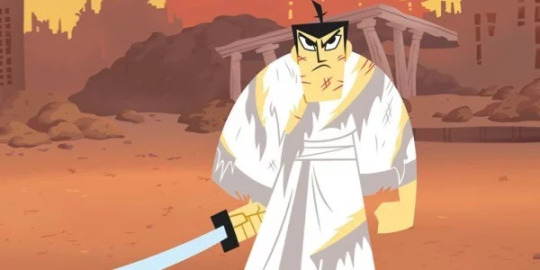
Avatar: The Last Airbender
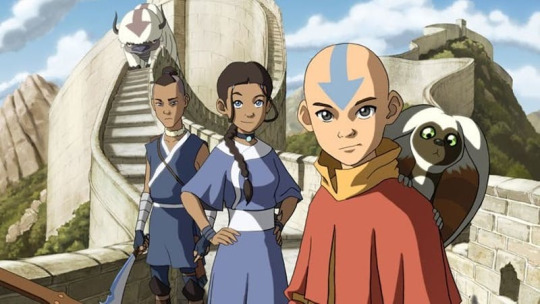
Fosters Home for Imaginary Friends
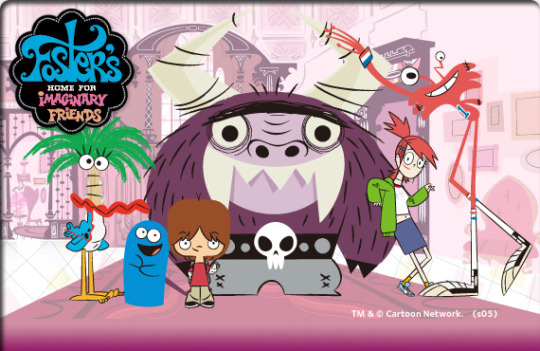
Recess
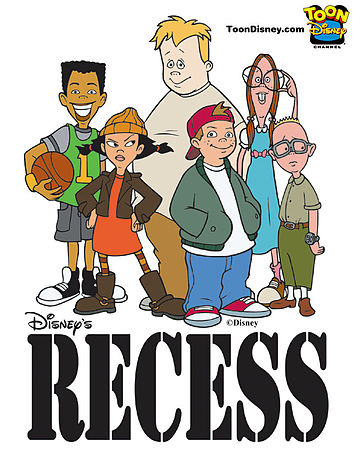
Proud Family and so many more

But now in modern cartoons, most cartoon shows are using a similar style of animation which many people called it “Calarts style”. Most cartoon shows are using because it’s cheap however it takes away creativity, more detail nor being organic. Look at Infinity Train, compare from the pilot to the release
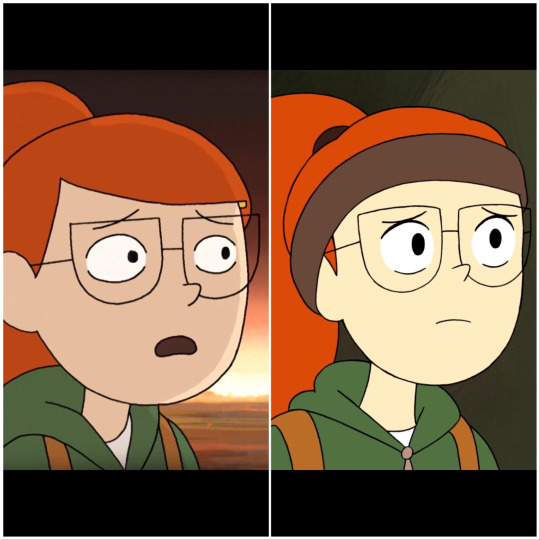
It looks very boring having most cartoons look the same. Then there’s artistic freedom where creators let them draw whatever they want such as Steven Universe and OK KO. That sounds good but really though it just looks lazy and unprofessional. This is very distracting that most characters go off-model every scene like why Rebecca and Ian-Jones Quarry think it was a good idea!

Great to Below Average
So now let’s talk about the three shows that were once popular Steven Universe, Voltron, and Star vs The Forces of Evil. The trope I’ve been seeing as of late about these shows that it was pretty hype and they deliver on that. All they need to do is conclude it and call it a good cartoon but then crash and burned in later seasons.
Steven Universe didn’t get popular until “Jailbreak” and that was when everyone was watching it. It had character development, an interesting world of gems, a gorgeous background and has one of the best soundtracks. This isn’t surprising because the creator is the same person who wrote Marceline episodes in Adventure Time which was Rebecca Sugar that created the series. Then season 4 and season 5 happened which the show drop in quality like mostly the show prefer showing filler which makes the plot go too fast and made arcs underwhelming, crystals gems and Lapis Lazuli and Peridot aren’t being used that much in the show and having each villain being beaten by simply talking to them. While there is Steven Universe Future but that hasn’t gotten interesting in my opinion.

Star vs The Forces of Evil is a show used to be interesting for the two seasons and “Battle for Mewni” arc but then shipping drama got out of hand and that resulted to fell from grace
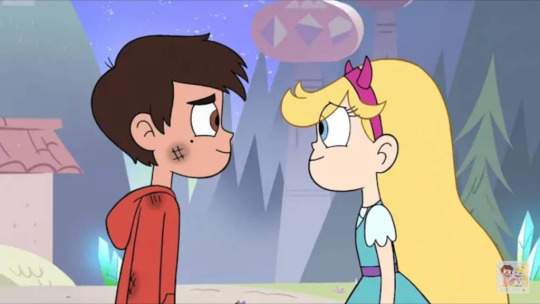
Then there’s Voltron and we all how that turned out for the last two seasons
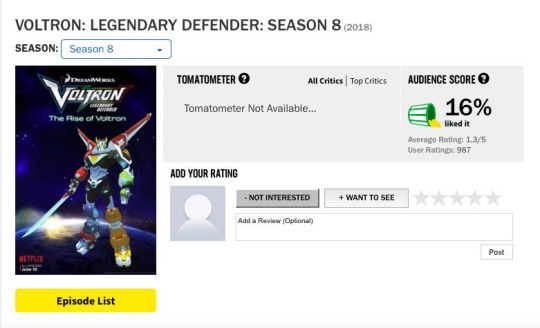
What these three have in common that they set up this interesting premise and world in the first few seasons but they all went downhill. Awful character writing, insane plot twist, and terrible pacing. I did wish that those shows would get better like how Adventure Time and Regular Show had one bad season but after that, they both got better but they didn’t and it went from being great to disappointingly average.
Comedy Over Messages
Now that’s got the most hype shows, let’s talk about shows that not many people talk about because the premise and world aren’t engaging enough to watch and which they are We Bare Bears, Craig in the Creek, Clarence, OK KO, and The Loud House. While I’m not saying they aren’t bad but it is just not interesting to watch, it's just that it’s too tame and too comedic. The main issue I have it doesn’t really teach viewers like they used to anymore
OK KO was about to talk about gun violence but they turn it into a comedy. In “Let’s Not Be Skeletons” people overuse the gun and resulting everyone to turn skeletons and KO tries to stop it but fails. By the end of the episode, it was a dream and calls Congress to stop it from happening. I really hate how writers of this episode of making a serious issue turn into comedy and that’s a pretty awful way of doing it.
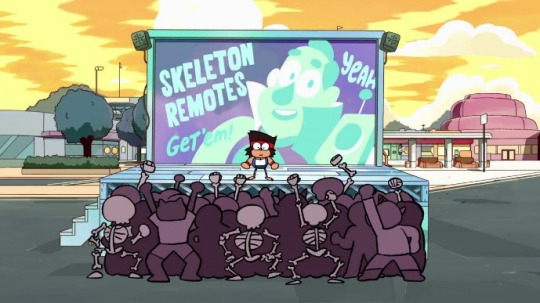
Look at Static Shock and Fat Albert, instead of making Gun Violence a joke, they talk about how serious it is by having someone shot and that devastated the characters a lot
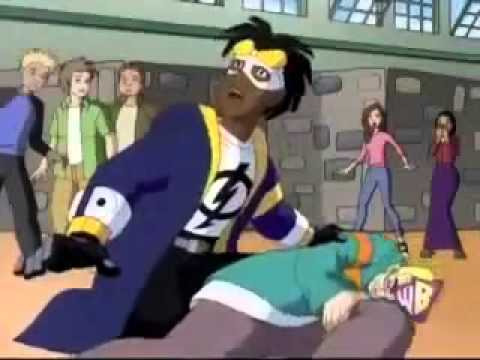

Then there's Hey Arnold, it really dives into serious issues such as
“Pigeon Man” showcases that some people are meant to be with other people while others like Pigeon Man are just different and can’t be with other people.
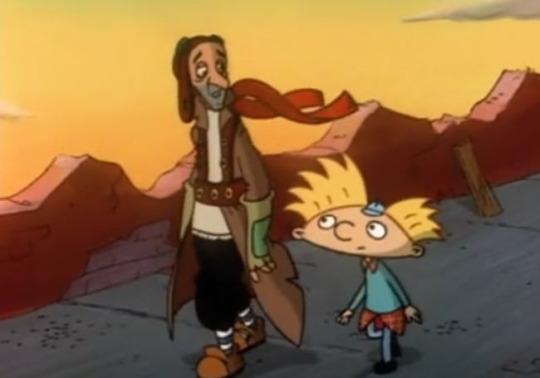
“Helga on the Couch” showcases Helga's anger issues and those issues manifest because her family ignores her because of her sister. Never truly cares for like no makes her lunch for school and no one brought her to school when she was a young girl. The only person that cares for was Arnold.
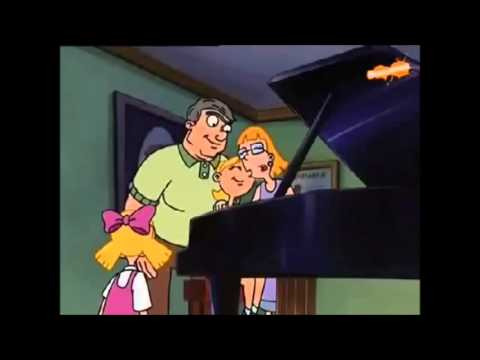
Then there’s my personal favorite, “Arnold Christmas”. Mr. Hyunh is always sad at Christmas and this episode revealed that he had a daughter and all he wanted was to see her grow up but there was a war coming near his village. In order to do so, he had to give her up so she can have a better life. It took 20 years to get out of the country and he almost gave up hope to find her until Helga helped Arnold to search for her and be reunited with her father.
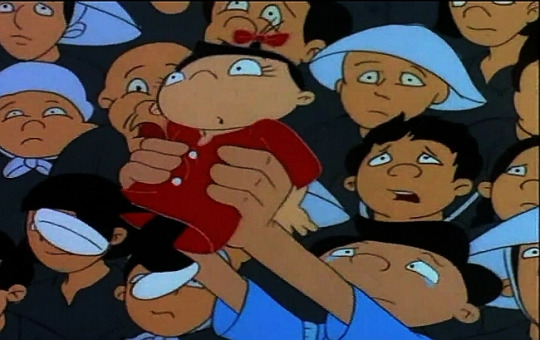
Modern cartoons don’t show those kinds of messages anymore and there’s something worse than that and I hate how cartoon shows keep doing this.
Today’s Villains
I” ve been seeing a lot lately that the main antagonist isn't handled well in cartoons as of lately. Most villains have been getting redeemed lately and not paying their crimes. While show creatures try to make them sympathetic and the victim however it doesn’t excuse them for their crimes.
White Diamond who caused multiple mass genocide on worlds, brainwash any gem that stands in her way and shatter gems gets easily defeated by simply getting talk to and just not gonna do it anymore because Steven said so.
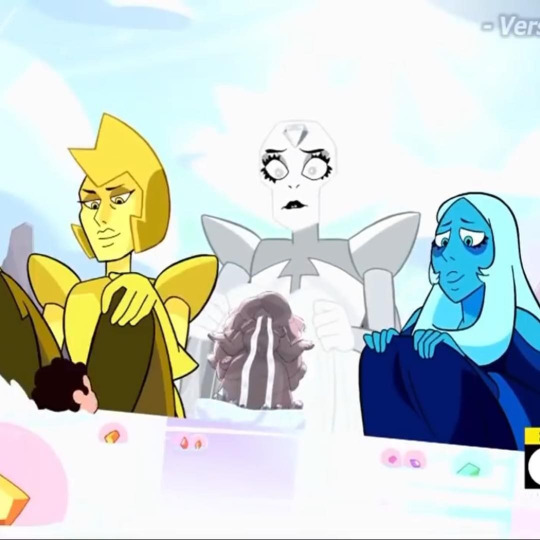
Mina Loveberry and her Mewni soldiers wanted to destroy monsters. When her and her army magic depleted, she just goes in the wilderness and no one stopped her.
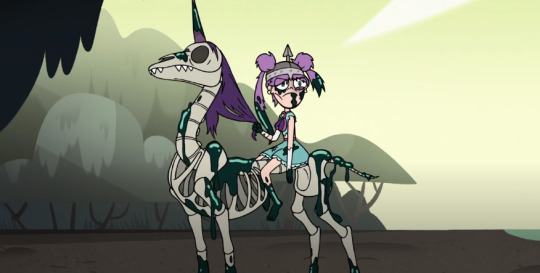
Moon Butterfly helped Mina create her soldiers so she can retake the throne from Ecipsa. Instead of having the monsters and her surrendering the throne that she was attending to do, however, her plan backfired when Mewni Soldiers and Mina wanted to kill all the monsters. Why didn’t Moon saw that coming, they were clearly racist against them. Then by the end of the show, she never once apologized for what she has done.
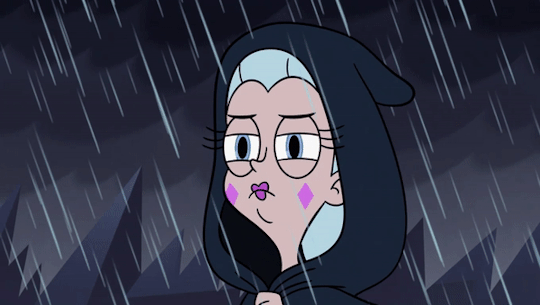
Starlight Glimmer created a cult that no one has cutie marks until the mane six defeated her in “Cutie Map” She returns and her revenge on Twilight by going back in time and making sure Rainbow Dash doesn’t perform the Sonic Rainboom. After multiple going to multiple timelines, she finally catches up to her and then her tragic backstory been revealed and it was very disappointing. The reason she caused all of this because her friend moved away and that’s it. That’s not all, instead of her facing her crimes like most villains such as Tirek or Queen Chrysalis, she gets off the hook and she became friends with Twilight in a matter of minutes
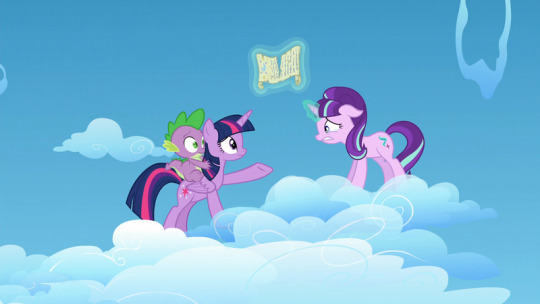
A good example of a good antagonist is Aku from Samurai Jack. When he first appeared in the show, he’s pure evil, destroying anything that stood in his way and ruling over the weak but as the show progresses, the serious villain became more comedic villain but that doesn’t mean he’s a silly character, he’s far from that. He’s still all-powerful and should be taken seriously. This is what I want from a villain. He’s powerful, he’s truly evil and has a personality.
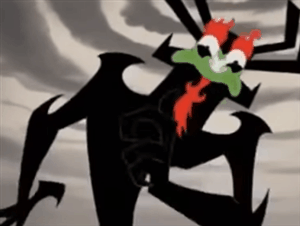
Villains can be sympathetic and relatable however shouldn’t be forgiven so easily. When a character crosses the line by taking multiple innocent lives should never be redeemed, even if they have a sad backstory
Cartoons lately have become less popular in this past decade, the glaring problems about cartoons are its animation, comedy over messages, messy plots, and terrible villain. People will only talk about cartoons from the late ’80s to 2012. I’m afraid that this day of age that it isn’t appealing anymore than in previous years. The only animation that people will talk about is anime shows which I can’t lie, is far superior to cartoons as of now. I feel that the only way it can make it back on top is it needs something like Adventure Time or Gravity Falls moment that reinvent it more relevant and view to modern audiences. I really do like to watch cartoon shows for animation, message, and characters but I keep seeing issues in modern cartoons and I hope that it will change in the future.
#Adventure Time#My Litte Pony: Friendship is Magic#MLP:FiM#Regular Show#Gravity Falls#Steven Universe#OK KO Let's Be Heroes#Craig of the Creek#Steven Universe Future#Star vs The Forces of Evil#Voltron#Clarence#Infinity Train#She-Ra#The Amazing World of Gumball#We Bare Bears
4K notes
·
View notes
Note
📁
Specifically, any headcanons of the Sodor Engines interacting with the internet, or the internet in general?
For some reason, I’d imagine that podcasts and the like are popular among vehicles in general.
That is a question that I've been working on for some time - because I'm workshopping my own Tornado headcanon (and boy oh boy does she use the internet a lot) - but I have some ideas for the Sodor engines as well:
Henry is probably the most "plugged in" engine on the island, weirdly enough. One of his drivers gave him an iPod back in the early 2000s, and kindly preloaded it with a bunch of torrented music.
BTW, that works because all the engines are now equipped with automatic train warning systems, and the little on-board computer has a USB port - as a nice side effect it allows music players to work with the engines in the same way as bone-conducting headphones do. The computer also acts as some kind of computer interface, which I am not going to explain how that works because Jesus Christ I don’t know how it does either.
Henry has managed to upgrade his iPod a few times since thanks to hand-me-down units from NWR staff, so he eventually got his buffers on a wifi-enabled iPod Touch and now downloads new music from the station wifi. He does listen to podcasts, but as every other engine will tell you, you could show Henry ten thousand new and exciting songs from the best artists in the world, and his top ten played songs are still going to be Genesis, Phil Collins, and Yes. Bear considers it a win that he managed to convince Henry to regularly listen to Rush after a mere twenty years of convincing.
Mavis and Daisy listen to a very interesting program called The News, because as stated elsewhere, they invest a shitload of money and need to be on top of things. Thomas and Percy wish that Daisy would use headphones or something similar to that, instead of listening to Bloomberg TV at loud volumes in the middle of the night. Toby frankly doesn’t mind, as it’s very nice to be kept up-to-date on the outside world.
In a move that surprises no-one, Bill and Ben have a podcast where they talk about whatever they think about at that moment - usually horse-racing, investing, and clay mining. As such, they have a wide audience, almost none of whom know that they’re that Bill and Ben, as their podcast is audio-only.
In an also unsurprising move, Edward and BoCo have been made very much aware that Bill and Ben have a podcast, but are still unsure as to what the hell a podcast is, despite being frequent guests on it.
Of the main line diesels, only Bear has shown any real interest in the internet, and was immediately put in charge of the Amazon Alexa when a unit was installed in the diesel shed. He also has an iPod that he got for Christmas a few years back. (The NWR has a very good personal electronics recycling program called give it to Henry, he’ll make use it.)
Bear does listen to podcasts as well as music, but his choices are so insufferably boring that even Henry refuses to listen to them. (I don’t really listen to podcasts - despite making one - so insert the most boring podcast you can think of here.)
As for other internet uses...
Gordon is very up-to-date on the newest social media trends - somehow - but only really cares when he is involved. He won’t admit it, but he’s been trying to figure out how to work a camera/selfie stick for some time so he can start up his own Instagram account. So far he has been unsuccessful, but one day he will manage it.
James has had an ongoing feud with his own Wikipedia page for about a decade now. The article sourced most of its information about his construction off of some out-of-print book about the L&Y. The book in question is accurate about James’ class, but not James himself - as he was a prototype engine. There’s no other primary sources available, so the very dedicated Wikipedia mod who created the page won’t change it - no matter how much James complains that he was there! He knows what happened!
Every now and again a TTTE fan blog/tumblr will make a post about hypothetical “ships” of the Sodor engines. Most of the time it’s shipping the core characters like Gordon and Henry, much to Gordon’s bafflement and Henry’s amusement!
Only one blog (a ttte fan tumblr by the curious name of @mean-scarlet-deceiver ) has gotten it right. Henry actually reached out to congratulate this blogger, but was unfortunately mistaken for a very dedicated roleplay account.
James is very annoyed by these blogs, as they have never once correctly guessed who he is “shipped” with! He has tried several times to be seen in public with Delta, but these events have never gone as planned - the “best” instance is when Edward rolled by at exactly the wrong moment, leading to months of speculation that JamesxEdward was the ship to look out for!
Thomas, being a generally oblivious sort of engine, was totally unaware of the online fan community around the TV show until he started getting actively harassed by vloggers and Instagrammers in the early 2010s. He’s fine with it now, but it was a deeply unusual experience for most of 2012.
Toby has developed an unexpectedly popular following on social media following his collab with Stormzy. His official twitter is huge now, with over a million followers, even if he has no idea what to do with it. He posts rarely, but usually manages to make an incredible post when he does.
No-one is sure who told Oliver what a “fan-production” is, but if you manage to get ahold of him for any period of time and ask him nicely, he will lend his voice to your TTTE fan-project, so long as it isn’t about [INSERT TERRIBLE SOCIAL/POLITICAL VIEW(S) HERE]. This means that he has 100% voiced dramatic readings of NSFW Fanfics before, which is always an absolute riot to spring on people unannounced.
There is a series of slice-of-life TTTE fanfics on Ao3 that have been written with such accuracy and innate railway knowledge that people are sure it was written by a Sodor engine, but nobody knows which one.
The Culdee Fell Railway has very active Instagram, Twitter and YouTube accounts, with all of the engines and coaches showing up regularly. It’s about the closest any of the railways on Sodor have come to what those outside the UK would call “normal locomotive social media”.
The Skarloey Railway has social media accounts too, but they don’t really feature the engines in any meaningful way, instead being used as a normal service announcements page.
The SR is a real working railway that doesn’t rely on tourism money as much as the others do, so they get a bit of a pass here.
The Arlesdale Railway has Twitter and YouTube, which didn’t usually get a lot of hits until 2020, when Ivan and Amanda Farrier started badgering the staff to make some videos just to alleviate some boredom. So far the most popular videos on the channel are a front-mounted camera video of the entire line slow-tv style, Bert explaining how steam engines work, and a video of Mike complaining about Justin Bieber for a solid half-hour.
That’s about it as far as Sodor goes, but before we’re done, I want to take a moment to talk about Tornado, because I have some fun ideas for her...
First of all, we need to establish that Tornado is very young. Her construction only started in late 90′s, and she was steamed to life in 2000, putting her firmly into the “Zoomer” category. Add in the fact that she was built by a bunch of old men who didn’t really know how to treat a new engine, and she was raised much more like a human than a locomotive - I’ll get to this much more in the proper Tornado Headcanon post, but what this means here is that when social media started being a thing in the mid-to-late 2000′s, the people at the A1 Trust decided that they needed a young person to run things like Twitter, Facebook, and Myspace... and, well, Tornado was the youngest person in the trust by a large margin.
I should state here that in the rest of the world, locomotives are on the internet at roughly the same level as humans are, so there’s plenty of equipment to connect a phone/computer/camera to an engine - being English, the A1 Trust didn’t know how common it was, but they managed to get it up and running just the same.
So Tornado has very quickly become attuned to the internet, just like any other teenager would. (yes, let’s let that settle into our minds for a moment - Tornado is barely old enough to drink in the US!) Quite naturally that means that she knows social media inside and out, and is actually quite a proficient social media manager for the trust, managing all of their social pages. More than one person who has complained about the trust on twitter has unknowingly been complaining to Tornado herself!
“On the internet, nobody knows that you’re a dog Engine”.
Tornado has her own personal social media accounts too, but most/all of the time she gets mistaken for a very dedicated role-player, as the general perception of British Locomotives is that they don’t tweet. This has resulted in some amazing reactions from podcast hosts (because, as you might expect, Tornado is very knowledgeable about steam traction in the 21st century, and tweets about it often, so train podcasts want to talk to her) when she gets invited onto video calls, turns on her webcam, and is met with screams from people who suddenly realize that her profile picture is accurate.
By far the best instance of this is when she was invited onto a video call with a railfan podcast. She was at the NRM at the time and managed to convince them to let her use their Skype setup. A wide-angle lens was needed because she was on the turntable in the Great Hall, so that podcast quickly got sidetracked when her webcam was turned on and revealed Tornado, with Mallard, Evening Star, City of Truro, and Green Arrow visible behind her. Whatever the original topic was quickly got thrown out in favor of a 2-hour Q&A with some of the most famous engines in the UK.
#ask response#the internet#ttte thomas#ttte toby#ttte bill and ben#ttte gordon#ttte daisy#ttte mavis#ttte henry#ttte bear#ttte oliver#tornado#nrm#trains using the internet#ttte#sodor#sodor shenangians#the formatting on this one is super fucked up and i can't figure out how to fix it - sorry
99 notes
·
View notes
Text
The Strange Saga of Spinosaurus, the Semiaquatic Dinosaurian Superpredator
I’ve been captivated by dinosaurs for as long as I can remember. My parents tell me that I told them that I wanted to be a paleontologist as early as age four. Naturally, then, I had lots and lots of books about dinosaurs when I was a boy growing up during the 1980s. One of the dinosaurs that always fascinated me the most was Spinosaurus aegyptiacus. Found in 1912 in the Bahariya Oasis of the Western Desert of Egypt (could anyplace sound more exotic to a small-town kid from upstate New York?!), Spinosaurus was originally known from a highly incomplete but also very large and extremely distinctive partial skeleton found in a middle Cretaceous-aged (roughly 95-million-year-old) rock layer in the oasis. Among the few skeletal elements known were part of a strangely shaped (for a dinosaur) lower jaw, some crocodile-like teeth, and most strikingly, several back vertebrae that each sported tall spines, some of them measuring nearly six feet. These spines clearly impressed Ernst Stromer von Reichenbach, the German paleontologist who studied the skeleton and gave the animal its name in a 1915 publication. Tragically, however, that original Spinosaurus skeleton—and all of Stromer’s other dinosaur fossils from Egypt—were destroyed during the Second World War, more specifically in a British Royal Air Force bombing of Munich on April 24, 1944. The story of Stromer’s lost dinosaurs found its way into many a children’s book, including several that I read cover-to-cover. As such, the tale took on near-legendary status for me, and, I’m sure, many other young dinosaur enthusiasts around the world. Here was an absolutely extraordinary dinosaur from a faraway land, similar in size to the gargantuan Tyrannosaurus rex, but clearly very different from all other predatory dinosaurs known at the time – and it was represented only by a few teeth and bones that had been blasted into oblivion decades ago and so now existed only as pictures in books.

A scan of my photocopy of plate I of Ernst Stromer’s original 1915 publication on Spinosaurus aegyptiacus, showing some of the teeth and bones preserved in the holotype (= name-bearing) partial skeleton, discovered in 1912 in Egypt’s Bahariya Oasis. Check out the long spines on the back vertebrae at lower left!

Stromer’s conception of Spinosaurus, as depicted in a 1936 publication and on a glass slide of his that colleagues of mine scanned during our visit to the Paläontologisches Museum München in Munich, Germany in 2001. Stromer knew this animal was big, as evidenced by the human skeleton he included for scale. Interestingly, too, he reconstructed Spinosaurus with unusual proportions for a carnivorous dinosaur, such as an abnormally elongate torso and short hind limbs. We’ll come back to those odd proportions a little later…
When I arrived in graduate school at the University of Pennsylvania in 1997, one of the first things I did was make a lengthy list of all the paleontological sites I was interested in exploring, ranked by their potential (in my mind, at least) to produce scientifically significant finds. The Bahariya Oasis and the search for a ‘replacement Spinosaurus’ quickly rose to the top of the list. Amazingly, no one had ever found—or at least officially reported—new dinosaur fossils in the oasis in the more than half-century since Stromer’s beasts were obliterated during that fateful airstrike. A need to keep this post to a reasonable length prevents me from describing the stars that had to align to make this happen, but in January 2000 I found myself in the Bahariya Oasis—one of the places I’d dreamed about going since I was a small child—as part of the first significant ‘dinosaur hunt’ to take place at the site since the early 20th century. It was bittersweet, though, in the sense that we never really found that ‘replacement Spinosaurus’ I’d fantasized about – all we ever discovered of that creature were a few isolated, fragmentary teeth and bones (and, in a very different location, a couple previously unpublished photos of the original skeleton in a Munich archive). We did find and dig up a gigantic new species of long-necked, plant-eating sauropod dinosaur, Paralititan stromeri, a creature that to this day is one of the largest land animals of any kind that’s ever been found, anywhere – but that’s another story for another time.

One of the rare contributions that I personally have made to scientific knowledge of Spinosaurus: a glass slide showing the only known photo of the right dentary (tooth-bearing lower jaw bone) of the original, name-bearing partial skeleton from Egypt. Like all of Stromer’s Egyptian dinosaur material, this specimen (including this bone) was destroyed in a British air raid on Munich during World War II. Several colleagues and I ‘rediscovered’ this photo—which nobody apparently knew existed—in an archive at the Paläontologisches Museum München in 2001. We published it and one other previously unknown photo of the Spinosaurus type specimen in a 2006 paper in the Journal of Paleontology.

A much younger yours truly digging up the incomplete left humerus (upper arm bone) of the gigantic sauropod (long-necked herbivorous dinosaur) Paralititan stromeri in the Bahariya Oasis of Egypt, February 2000. Paralititan is one of the largest dinosaurs ever discovered – a nice ‘consolation prize’ given that we didn’t find much of Spinosaurus during our expeditions to Bahariya. (A cast replica of the complete right humerus of Paralititan is on display in PaleoLab at Carnegie Museum of Natural History.) Credit: Josh Smith.
Back to the matter at hand, meaning Spinosaurus. Fast-forward to 2011. I had the honor of serving as the external thesis examiner for Nizar Ibrahim, a promising doctoral student at University College Dublin in Ireland. I’d known Nizar for years, ever since he reached out to me by email while an undergraduate at the University of Bristol, England, to discuss our mutual interests in African Cretaceous dinosaurs. Nizar’s Ph.D. thesis was on dinosaurs and other middle Cretaceous-aged vertebrates from the celebrated Kem Kem beds of southeastern Morocco, a set of rocks that had yielded a fossil fauna very similar to, though seemingly more diverse than, that of the Bahariya Oasis. Among the many finds that Nizar documented in his colossal thesis were intriguing new remains of Spinosaurus. I went to Dublin to participate in his successful thesis defense, and afterward, he and I hit up some of the city’s finest public houses to celebrate (no surprise for those who know me). Over a pitcher of yummy Irish stout, he told me an exciting story – he and his team had lately discovered not just isolated bones of Spinosaurus in Morocco, but parts of a probable new skeleton. If so, this find would be the first skeleton since Stromer, and moreover would be exceedingly important given how little was known about Spinosaurus, even as recently as the early 2010s. The more parts we paleontologists have of a given fossil animal, the more we can generally learn about it, so the prospect of a new and relatively complete Spinosaurus skeleton—in other words, many bones belonging to a single individual dinosaur—was thrilling to say the least.
Again I’ll skip details for brevity’s sake, but fast-forward once again, to 2014. I was contacted by an editor of Science—one of the foremost scientific journals in the world—to peer-review a paper that had been submitted by (you guessed it!) Nizar and a long list of collaborators describing that new skeleton of Spinosaurus that he’d told me about over beers in Ireland three years before. Nizar and team had revisited the quarry and it had panned out in a big way. From this one, single individual Spinosaurus—again, the first associated skeleton of this dinosaur to have been found in roughly a century—they had bones from the skull, backbone (including a few of those famously long-spined vertebrae!), forelimb, pelvis, and hind limb. More importantly, these ‘new��� bones revealed that Spinosaurus was even more bizarre than anyone imagined! We already knew, from Stromer’s specimen and other, isolated finds made through the years, that the shapes of the skull and back were really weird for a predatory dinosaur. Now, the new skeleton showed that the bones were remarkably dense, the hind legs were oddly short, and the hind feet may have been webbed! All of this led Nizar and colleagues to propose that Spinosaurus may have been semiaquatic; in other words, that its lifestyle was much more comparable to that of a modern-day alligator or crocodile than it was to a more ‘typical’ land-living predatory dinosaur such as T. rex. Other evidence for an affinity to watery habitats had been found in Spinosaurus and closely related dinosaurs (known, perhaps unsurprisingly, as spinosaurids) before, but this was, in my mind, the most convincing case yet made that these animals spent significant amounts of their time at least partly submerged in lakes and rivers. The paper was published in Science a few months later, accompanied by a cover story in National Geographic magazine and a special on the venerable PBS TV series NOVA. Almost exactly one hundred years after it had been named, Spinosaurus had become a celebrity.

Nizar Ibrahim and colleagues’ initial conception of Spinosaurus aegyptiacus in the flesh, released to coincide with the publication of their Science paper in 2014. Two aspects stand out: as Stromer already knew (see his skeletal reconstruction above), the animal is enormous, but it was more oddly proportioned than even he had imagined. Note also the ‘regular-looking’ (for a dinosaur) tail, and read on. Credit: Davide Bonadonna.
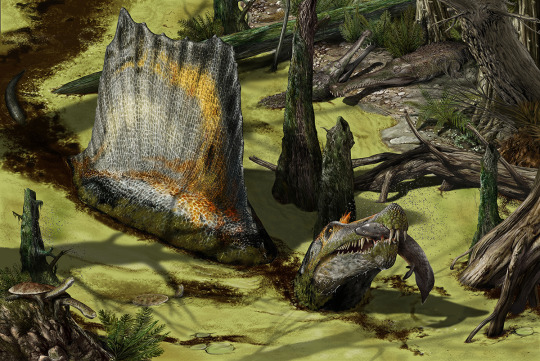
Semiaquatic Spinosaurus chowing down on a tasty lungfish in what is now northern Africa some 95 million years ago. Italian paleoartist Davide Bonadonna has produced some of the most beautiful and accurate modern depictions of this extraordinary dinosaur, and I’m grateful to him for letting me reproduce his art here.
But the story didn’t end there. Some prominent paleontologists criticized Nizar and colleagues’ semiaquatic interpretation of Spinosaurus. These opinions weren’t a final judgment. Instead, this is just how science works: we scientists propose ideas, or hypotheses—in this case, that Spinosaurus lived and behaved more like a crocodile than your garden-variety carnivorous dinosaur—and then test these hypotheses by reevaluating the existing evidence and/or bringing new information to light. If a hypothesis repeatedly stands up to testing, then it gradually gets incorporated into the body of knowledge. Other paleontologists presented evidence that they claimed refuted the semiaquatic hypothesis, but Nizar and team eventually countered with new data of their own. In late 2019, another prominent scientific journal—this time it was Nature—came calling, asking me to review a second paper by Nizar et al. on Spinosaurus. What, I thought, could these researchers have to say about this dinosaur that they hadn’t already said before? Well, as it turns out, Nizar and colleagues had kept digging at their Spinosaurus skeleton site, and incredibly, they’d continued to find important new bones belonging to the same specimen. Among these post-2014 finds was the almost complete tail. When I saw what it looked like (via an illustration in their paper), I literally laughed out loud with surprise and delight. Somehow, the shape of the Spinosaurus tail Nizar’s team had discovered—the first even reasonably complete tail of this dinosaur to have ever been unearthed—was simultaneously both unexpected and predictable. It looked really dissimilar from the tails of other predatory dinosaurs, but it was nearly exactly like what one might expect for a dinosaur that used its tail to propel itself through water. In other words, the tall, fin-like tail of Spinosaurus looked more like that of a supersized alligator or newt than that of T. rex.
Nizar and team’s Nature paper on their Spinosaurus tail was published this past April 29. Is it the last word on this dinosaur and its mode of life? Most certainly not, but the evidence is now stronger than ever—in my opinion, very strong—that Spinosaurus spent more time in the water than any other non-avian (= non-bird) dinosaur that we currently know about.
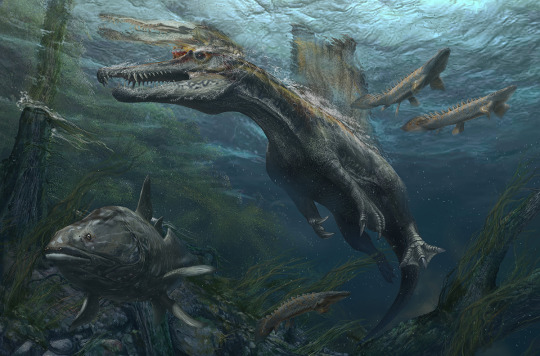
The modern view of Spinosaurus, not as a ‘regular’ predatory dinosaur, but rather as a specialized semiaquatic hunter that spent much of its life in the water. Self-serving side note: the three smaller, spiky-looking fish are Bawitius bartheli, a polypterid (an archaic, still-extant group of thick-scaled ray-finned fishes) that several colleagues and I named in 2012 from fossils found in the Bahariya Oasis. The larger fish at lower left is the giant coelacanth Axelrodichthys (sometimes called Mawsonia) libyca. Credit: Davide Bonadonna.
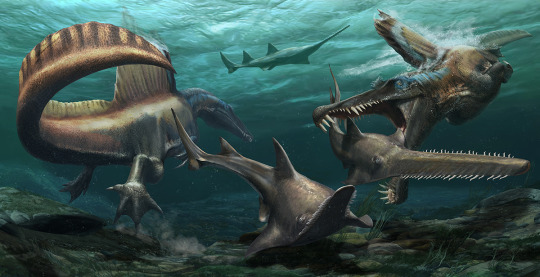
Two Spinosaurus invite the sawfish Onchopristis numidus to lunch in what’s now northern Africa some 95 million years ago. Look at those fin-like Spinosaurus tails! Credit: Davide Bonadonna/National Geographic.
Nizar (who’s a Research Associate here at Carnegie Museum of Natural History), myself, and our many colleagues and collaborators are continuing to study the mysterious dinosaurs and other fossil vertebrates from the middle and Late Cretaceous of northern Africa. Indeed, Nizar and I have several collaborative papers in the works right now, and I’m also working with an amazing team of paleontologists at Mansoura University on multiple new Egyptian fossil finds. It’s a good bet that African Cretaceous dinosaurs even stranger than Spinosaurus are still out there, waiting to be discovered!
Further reading/watching:
Nothdurft, W. E., with J. B. Smith, M. C. Lamanna, K. J. Lacovara, J. C. Poole, and J. R. Smith. 2002. The Lost Dinosaurs of Egypt. Random House, New York, 256 pp.
Smith, J. B., M. C. Lamanna, H. Mayr, and K. J. Lacovara. 2006. New information regarding the holotype of Spinosaurus aegyptiacus Stromer, 1915. Journal of Paleontology 80:400–406.
Ibrahim, N., P. C. Sereno, C. Dal Sasso, S. Maganuco, M. Fabbri, D. M. Martill, S. Zouhri, N. Myhrvold, and D. A. Iurino. 2014. Semiaquatic adaptations in a giant predatory dinosaur. Science 345:1613–1616.
Bigger Than T. rex (NOVA documentary): https://www.pbs.org/wgbh/nova/video/bigger-than-t-rex/
Henderson, D. M. 2018. A buoyancy, balance and stability challenge to the hypothesis of a semi-aquatic Spinosaurus Stromer, 1915 (Dinosauria: Theropoda). PeerJ 6:e5409.
Ibrahim, N., S. Maganuco, C. Dal Sasso, M. Fabbri, M. Auditore, G. Bindellini, D. M. Martill, S. Zouhri, D. A. Mattarelli, D. M. Unwin, J. Wiemann, D. Bonadonna, A. Amane, J. Jakubczak, U. Joger, G. V. Lauder, and S.E. Pierce. 2020. Tail-propelled aquatic locomotion in a theropod dinosaur. Nature 581:67–70.
Matt Lamanna is Mary R. Dawson Associate Curator and Head of the Section of Vertebrate Paleontology at Carnegie Museum of Natural History. Museum staff, volunteers, and interns are encouraged to blog about their unique experiences and knowledge gained from working at the museum.
142 notes
·
View notes
Text
Why Harry Styles Just Scored His First No. 1 Song

Like any boy band alumnus, he first had to overcome radio’s bias against teen heartthrobs.
Late summer is a great time for sleeper hits: songs that have been hanging around the charts for months and finally hit their stride. Four years ago, in August 2016, Sia’s “Cheap Thrills” reached No. 1 after knocking around the charts since the prior winter, getting its final boost from a Sean Paul remix. In September 2018, Maroon 5’s year-old “Girls Like You” slipped into the top slot after wafting around the Top 10 for more than four months, with a Cardi B verse putting it over the edge. Last year around Labor Day, Lizzo finally topped the Hot 100 with “Truth Hurts,” a song that was two years old and had been rising gradually on the chart since the spring.
This year’s sleeper hit is “Watermelon Sugar,” a wisp of a song by boy bander–turned–self-styled rock star Harry Styles. With a name inspired by Richard Brautigan’s hippie-era, post-apocalyptic novella In Watermelon Sugar, Styles’ lackadaisical tune is not only a sleeper but a grower, the sort of hit that sneaks up on you—I wasn’t sure it even had a fully written chorus the first time I heard it, and I’m pretty sure I’m not alone. Indeed, the whole nation took its time deciding that this quirky ditty would give the starriest, most eccentric member of One Direction his first-ever U.S. chart-topper.
youtube
“Watermelon Sugar” is the third single promoted from Styles’ second solo album Fine Line, which was released last December. That alone is remarkable, given the challenge in the digital age of generating chart interest in anything other than an album’s first couple of singles. Generally, in an era when all of an album’s songs are available to be consumed the day the album drops, you need a remix or a special guest of some kind to gin up chart action months after the song first hits streaming. “Sugar” has none of those. To be sure, there was some gimmickry fueling the song’s leap to the top, albeit of an old-fashioned kind: The song had its best week of sales ever thanks to an assortment of limited-edition vinyl and cassette singles that came bundled with a digital download. Those sales got “Sugar” the last mile on the charts, but Columbia Records wouldn’t have put the physical goods on sale if the song wasn’t already a radio smash—“Sugar” currently has the second-biggest U.S. airplay audience—and they knew they had an opening between current hits by Taylor Swift and a pair of lascivious female rappers I’ll almost certainly be writing about in this space next week. So, fair play to Team Harry: They took advantage of an open chart window, a tactic as old as the Hot 100 itself.
As “Sugar” leaps from No. 7 to No. 1 on the Hot 100 this week—essentially switching places with his ex-girlfriend Taylor Swift’s “Cardigan,” which falls to No. 8—Styles scores only the second-ever chart-topper by a member of One Direction. That includes all of the hits by 1D itself. In its five years of recording, from 2011 through 2015, the band never scored a Hot 100 No. 1. This despite topping the Billboard 200 album chart with its first four studio albums, the only group in history to launch a career with that haul. So … what was that other 1D-affiliated Hot 100–topper I mentioned? It was by ex-member Zayn Malik, the only member to break from the crew while it was still active. Zayn’s smoldering, Weeknd-esque boudoir jam “Pillowtalk” debuted at No. 1—and spent a solitary week there—in the winter of 2016, fueled by blockbuster streams and downloads ginned up by 1D superfans still mourning his departure the prior year and the group’s resulting, presumably permanent hiatus.
Explaining how the top-selling boy band of the 2010s could shift so many CDs and downloads but generate only two No. 1 singles means briefly recapping the fraught history of boy bands and the charts. Selling albums has never been hard for pinup pop groups, since the days of Meet the Beatles! and More of the Monkees. And in the ’70s and ’80s, such precision sing-and-dance troupes as the Jackson 5, the Osmonds, and New Edition managed to generate both gold albums and chart-conquering singles. In 1989, New Kids on the Block had the year’s second-biggest album and four of the year’s top singles, including a pair of No. 1s. But starting in the ’90s, as U.S. radio networks consolidated (fueled by the 1996 Telecommunications Act) and programmers more narrowly targeted specific demographics, radio stations shied away from maximalist teen-pop that appealed primarily to under-18 audiences. By the end of that decade, even as boy bands were enjoying a new wave of TRL-fueled popularity, radio became a chart handicap for them. The Backstreet Boys and ’N Sync had the top-selling albums of 1999 and 2000, respectively—the diamond-selling Millennium and No Strings Attached—but only scored a solitary Hot 100 topper between them, ’N Sync’s “It’s Gonna Be Me.” (Backstreet never hit No. 1: The deathless “I Want It That Way” peaked at No. 6.)
This radio bias against boy bands has persisted into the 21st century. And ever since the Hot 100 went digital about a decade and a half ago, teen-pop’s chart placements have been the result of a battle between rabid downloaders and radio gatekeepers—massive digital sales compensating for modest radio play. For example, radio was what kept the Jonas Brothers from scoring any chart-topping hits during their original wave of teen idoldom; their biggest hit of the ’00s, the No. 5 hit “Burnin’ Up,” sold 2 million downloads but only ranked 55th at U.S. radio. By the ’10s, the same fate befell one-man boy band Justin Bieber. In this long-running Slate series, I have chronicled the blow-by-blow between Justin Bieber and radio programmers that swung from Justin as hit-starved teen idol in the early ’10s to dominant young-adult chart-dominator in the late ’10s. In the early ’10s period, Bieber was a YouTube and iTunes demigod with not a single radio smash to his name. He could sell a half-million downloads of “Boyfriend” in a week and still fall short of the No. 1 spot, thanks (no thanks) to radio.
For One Direction, the chart patterns were the same. A Frankenstein’s monster that Simon Cowell famously threw together in 2010 on his televised competition The X Factor from five solo competitors—Niall Horan, Zayn Malik, Liam Payne, Harry Styles, and Louis Tomlinson—1D continually found its singles dragged down on the Hot 100 by radio, even as the band sold truckloads of albums. The pattern was set in fall 2012 when “Live While We’re Young” debuted with a staggering 341,000 downloads but could only get to No. 3 on the Hot 100, thanks to its 50th-ranked radio airplay. In the summer of 2013, the slyly Who-interpolating “Best Song Ever” became 1D’s highest-charting hit ever, debuting at No. 2 with record video views and near-record downloads, but at radio it never got past No. 53. “Story of My Life” (No. 6, 2014), “Drag Me Down” (No. 3, 2015)—no matter how many downloads sold or videos viewed, 1D could never top the Hot 100 so long as its radio spins remained limited.
The reason I’m running down all of this granular chart data is it reveals the hurdles both 1D and its post-breakup soloists had to overcome to top the Hot 100. Like Justin Bieber, they had to become credible radio fodder with adults as well as kids. With his early break from the group, Zayn was the first to pull this off. Though “Pillowtalk” debuted at No. 1 largely due to massive sales and streams, the carnal song did eventually become a No. 4–ranked airplay hit. Cleverly, Zayn had chosen a then-current EDM-inflected R&B mode and dropped his debut while the Weeknd was between albums. Other former 1D-ers have had their share of solid radio hits, including Liam Payne’s hip-hop–inflected “Strip That Down” featuring Quavo of Migos (No. 10 on the Hot 100, No. 4 on Radio Songs) and Niall Horan’s softly bopping pop jam “Slow Hands” (No. 11 Hot 100, No. 2 Radio Songs).
And Harry Styles? He decided to make things harder on himself. His 2017 debut album was chockablock with old-school classic rock. This would be like launching a career in 1964 with big-band jazz. While Styles’ fame ensured a big launch for his Bowie-esque single “Sign of the Times”—it opened, and peaked, at No. 4 on the Hot 100, fueled by strong downloads—radio showed only moderate interest. It eventually reached a modest No. 21 on the airplay chart. Later Harry singles like the twangy “Two Ghosts” and the thrashy “Kiwi” missed the Hot 100 and had little radio profile beyond a handful of pure-pop stations that were loyal to Styles from his 1D days. One admired Harry for following his artistic muse—more Joni Mitchell than Justin Bieber—but as a pop star, he arguably squandered his momentum coming out of One Direction.
What has made Fine Line, Styles’ sophomore album, such a clever left turn is he retained the rock flavor he naturally gravitates toward but converted it into mellow California-style surf-pop, and he let his production team—Tyler Johnson and Thomas “Kid Harpoon” Hull—fashion the songs into percolating radio jams. Each single has opened the door a bit wider: “Lights Up,” a No. 17 last October, is lightly strummed beach music with ethereal backing vocals. And “Adore You,” a No. 6 hit in April (for my money, still Styles’ best single), is thumping electropop. “Adore” in particular served as Styles’ entrée onto radio’s A-list—it reached No. 1 on mainstream Top 40 stations and No. 2 on Radio Songs by early summer.
With this beachhead established, Harry was finally free to let his freak flag fly with “Watermelon Sugar,” which is simultaneously his oddest single and his most infectious. The chorus consists of nothing more than the line “Watermelon sugar high” repeated a half-dozen or more times, with emphasis on the “HIGH.” (TikTok users have keyed into this idiosyncrasy, sharing videos in which the “high” gets its own video edit of the user playacting her best stoner face.) Last November, when Styles did double-duty hosting and singing on Saturday Night Live, “Sugar” was one of the songs he performed, and in that indoor setting, it came off as willfully quirky and seasonally incongruous; the song’s first verse line is “Tastes like strawberries on a summer evenin’.” Now, timed for 2020’s beach season—complete with a video filled with beautiful people on the shore, shot just before the pandemic and, according to a title card, “dedicated to touching”—it’s sitting atop the hit parade.
In short, Harry Styles finally has a profile on the radio and on the Hot 100 that matches his profile on magazine covers, and he achieved it on his own schedule and something like his own terms. Like John Lennon in the ’70s—the founder and nominal leader of the Beatles but the last former Fab to reach the toppermost of the poppermost as a solo artist—Styles just had to find his own way. As that onetime teen heartthrob sang, “Whatever gets you to the light, it’s all right.”
source: Slate
153 notes
·
View notes
Text
This is just me talking about (my) asexuality and aromanticism and mainly about how I figured I'm aroace. I'm from Finland and recently turned 30 so my experience and "lgbt+ history" might not be what you know it as, especially if you are not from Europe, or if your native language is English.
Also this is highly personal, so I doubt anyone here will have 100% same experience. But that's fine because remember: we're all individuals here and these are NEVER universal. You're still valid even if you wouldn't relate to what being aspec is to me.
It might be IS a long post so beware, but I've just been feeling like writing down some thoughts so here we go...
What I have been able to track is that I was 17, in 2008, when I first stumbled upon the term "asexuality". I don't remember exactly how, but I just remember reading about it and immediately going "yeah that's me". But what I do remember is that no one talked it being about sexual attraction. Basically how understood it was: asexuality = sex-repulsion.
I was 17, and somehow I knew I was sex-repulsed, but at the same time also thought I'm just a minor, so it's normal to be sex-repulsed. But even after turning 18, I don't recall ever feeling sexual attraction. I didn't think of myself as a "late bloomer" but just as someone who just has no interest towards sex. At some point I became really anxious of men, however. Nothing has ever happened to me* but still I, for some reason, developed terrible fear of men. I'm afab and just did not want to be seen as an object, and it made, still makes me, terrified to think someone might look at me and have Emotions. I know that we can't control our brains, I mean, I can't look at someone and force myself to feel attraction - just like those who do feel attraction, can't force themselves to stop feeling attraction. They can only control their actions. But yeah, I also had horrible (sexual) intrusive thoughts due to my generalized anxiety disorder at some point, which did not really help. They got a bit better when I came into terms with my asexuality and aromanticism, but sometimes they still come at me and it's never fun, but at least they're not as strong as what they used to be.
*(Unless if you can count that as sexual harrasment when, CW, I was 11 and a classmate was "into" me and tried to touch my face and talk "sweet things" to me but made it into a show despite me being uncomfortable and usually crying cos as a neurodivergent I didn't know how else to react.)
But anyway, back to the topic. So for years I understood asexuality as sex-repulsion, but I guess it's because I, well, am a sex-repulsed ace. So if I'm sex-repulsed, why would I then look at someone and feel something if I'm repulsed by the thing anyway? Like, it probably can't get any simpler than this :D And I know today that it's not as simple anymore. But that was 2008, at school (in ~2005) they only talked about gays a little, on one page in a sex.ed. book that otherwise was maybe 100 pages long. Only one page. About gays. And it was basically "Some boys like boys or some girls like girls and it's totally fine." and that was it, but the overall assumption was that everyone likes someone. And also there were no romantic orientations. Liking someone = both sexually and romantically. Not liking = not a thing except when you were depressed or otherwise mentally ill, or autistic or mentally disabled (which is a SUPER ableist take btw). I don't remember teachers ever talking about this, but it could also just be my adhd, maybe they did mention, but I just don't remember. At least in my notebooks there is no mention of this, everything was very much heteronormative and amatonormative, and also there was only two genders. I don't remember ever hearing about transgender people, apart from foreign documentaries and in them they were always portrayed as some shocking freaks of the nature, and loads of wrong terms were used. And this is still the mid and late 2000s we're talking about!
So this takes us to the other part aka aromanticism. Back then asexuality was not only sex-repulsion but also merged together with aromanticism, because people didn't talk about romantic orientations yet. So asexuality was not only sex-repulsion, but also you simply just not wanting a relationship. Again, nothing about attraction, just someone who did not care about sex nor relationships. A "forever single", if you will.
This was already annoying me a lot back then because I was really annoyed by sex "running the world". I was so angry because why is asexual the only sexuality that doesn't like sex? All the other sexualities had the assumption of them always wanting to have sex. Like, even think about someone who is straight, you hear that someone is straight, and you automatically assume(d) that oh they're into sex too cos why wouldn't they be. This was really driving me nuts because I was sure there are people who want to have a partner, but never want to have sex! I was still experiencing crushes, and I knew for sure it was nothing sexual, so it annoyed me that just because I'm asexual, it means I can't have crushes. That's why I actually called myself as "asexual bi" for a while, because "bisexual" indicated I would have not been sex-repulsed and I wanted to point out that I'm NOT into sexual things, at all - and remember that this was still the late 2000s or early 2010s and I had not heard of romantic orientations yet! So I was up to something, there just were no terms for that yet! Today that would be called bi-/panromantic asexual.
I haven't been able to track the exact date or even year when did I figure out I'm aromantic, or when did I hear about romantic orientations for the first time. From the messages I've been able to find, I was already in my early 20s. Aka somewhere around maybe 2011-2013. In those, I have still been wondering what I am or if I even want to have a relationship, not being really able to tell what I wanted or didn't want. Again, no one told me romantic orientations are about ATTRACTION and not about whether you have commitment issues or not (this as a half-joke, cos I have severe commitment issues with everything :D I need to feel free!).
Anyway, I do remember my key moment with aromanticism, or the "aromantic awakening" as you could call it too, was when I was 17 or 18. Or maybe I was older? I don't know, I have time blindness. Anyway, I had this one online friend I had a "crush" on (I think it was just undiagnosed adhd's person hyperfixation) and I even told her about it. Everything just is super shady, from those years, I was not really on my best and there are so many overlapping memories that feel like different alternative universes instead of memories on a same timeline. Anyway, I just remember at some point thinking about this girl and I thought about some "romantic" stuff, like kissing, and I just remember my brain going "NOOOOOPE!" I had wanted to meet with her some day so bad, but when I started thinking about actually meeting with her, I started to nope the fuck out. All I had in my head was awkward embarrassing "first kiss" scenarios from movies and I just was not having it! I basically went "lol I guess I'm aro too, then XD" but I still don't remember when did I have this realization. Was I 17? Or was I, say, 22? I guess I need to go through my old MSN Messenger and Skype convos some day to investigate this further because I really want to know. I couldn't even find anything from my Tumblr from those times (I registered here in 2011), but I don't know if that's just me not tagging or Tumblr search functioning normally (aka it never finds anything).
But yeah, I am touch-repulsed. And kiss-repulsed, and romance-repulsed, too, (unless it's my OTP we're talking about). I'm still not exactly sure if I'm touch repulsed because I'm aromantic, or if I'm aromantic because I'm touch-repulsed. I only know that because of my sensory issues (I'm neurodivergent), I have never liked touching nor being touched. Even as a little kid I hated hugs and never liked sitting on anyone's lap. I only tolerated my parents, mainly my mom, because they were my safe place as an extremely shy baby/toddler/kid, who was especially wary about men. I can't explain the latter, but there was something about adult men that caused me (as a baby) to hide my face against my mom's shoulder if they talked to me. I did that to everyone I didn't know, but especially to men I didn't know. No idea why.
I also remember how my siblings loved to sit on people's laps and were always climbing onto their laps, and I didn't like this. And once my (late) grandma was so touched when she asked me if I want to sit on her lap (I was maybe 5-7?) and I agreed just to make her happy. I still remember how it felt, and I did not like it at all, but it still made my grandma so happy that I THINK she almost cried when she told my mom I actually agreed to sit on her lap. I'm not sure how real this last part of the memory is because I was so young. But I do remember thinking I do that for a change because I knew my grandma would be happy.
So yeah, my touch-repulsion is not exactly a new thing but just something that has been a part of my personality forever. But is that the core reason for why I only feel aesthetic attraction? I never look at people and feel like I wanna touch. More of the opposite, the idea of having to touch them or them touching me makes me go "eeewww". If you have seen that video of a gibbon shaking their whole body after seeing a rat in their exhibit? That's what I feel like when I think about touching or being touched, in just any way, also platonically.
The only time I feel "sensual attraction" is when I see photos or videos of animals. The urge to pet a tiger is insane. But the feel of another human's skin or muscle (or hair or whatever) is very repulsive to me.
I still remember how disgusting it felt to e.g. sit on a cousin's lap. We sometimes used swings like this, and somehow I was aware of it not feeling nice, but still not doing anything about it cos it also was okay? Only later I have realized I really, really loathe the texture of human skin. Or the warmth and overall feeling of a human body. For example, I was at least 7 or younger when I sat on my cousin's lap while we were sitting on a swing and STILL, after over 20 years, I have that all in my body memory. I remember how the thigh bone felt under my legs and how freaking disgusting the muscles felt inbetween. Also at school, on the 1st grade, we often had to walk in a line of twos after the teacher and hold the pair's hand so no one gets lost. My then-friend had so ridiculously dry skin that the only thing I could think of was how I felt like throwing up because the skin on her palm felt so damn disgusting. I still can feel that in my hand when I think of it. That's one of my "core memories" from 1st grade - how disgusting the human skin can feel like.
I don't think I have ever felt actual romantic attraction towards anyone. It's really difficult to differentiate because as I mentioned, I get those people hyperfixations easily. I guess it's the same hormones but I never really want to do anything with them? I guess it's the emotional intimacy that "attracts" me and what gets me excited, but I'm still not exactly sure what emotional intimacy means to me. I don't exactly fall into the QPR category either, in a way I wish I had a best friend whose best friend also I would be, and that neither would have anyone else who is "better" than the other one. But the only intimacy there would be emotional intimacy, nothing else. And I need my freedom so I wouldn't move in with any human being, either.
Sometimes I've thought my "ideal partner" would be a robot because if I get annoyed, I could just turn it off and stuff into a closet and leave there, and if I felt like not having a "relationship" anymore, I could just remove the harddrive and destroy the robot, or both. That way I would be the only one with the memories, and I wouldn't have to worry about someone out there knowing things about me, things that only the closest can know, and I'm really afraid of letting anyone close in case it won't work (also with regular friendships) because I can't stop thinking about how much I wish I had that MIB memory cancelling device so that they would again know almost nothing, or at least much much less about me. There's already one friendship that ended a few years ago and I still keep thinking about how I wish I could take everything back and how I wish they delete(d) all the files and drawings and stuff I sent them. There are so many things about me I wish I never told them, now as we are no longer friends. Back then it felt like "of course this is gonna last a lifetime!" but turns out that nope, not all friendships will.
I guess it's time to stop rambling. This post is really long already. If you read it all the way here: congrats. And thanks. You probably just wasted your time but... that's on you I guess :DDD But yeah, some thoughts from a 30-years-old aroace who has been aware of their identity for at least or almost 10 years now.
8 notes
·
View notes
Text
Recognizing the OGs: An Homage to the Y2K Aesthetic
First, I would like to state that I am not a fashion writer of any sorts – so apologies for any under-delivery of this story. This is more of a brain-and-photo-dump that I suddenly decided to write about! So here goes.
It’s all over the For You page – vintage outfit inspo, “Y2K hairstyles”, generic dances to 2000s RnB hits (let’s not even get into that..) – all things 2000s/90s have come back into style. And to be honest, I’m here for it - for women of color, the 2000s and 90s were about being unapologetically vibrant and culturally sound. It even seems that there was more space for black women in the 90s and 2000s than there is now – as the 2010s rolled around, sitcoms that explored blackness fell off of the air, the RnB and Hip Hop sound that had been reserved for those who pioneered it joined forces with Pop music, and black culture became popular culture .
And so we come to 2020, an era where black and other American subcultures have been engrained into internet and popular culture so heavily that many (read: non-POC) cannot tell the difference. I could go on for paragraphs about the double standards for AAVE (African American Vernacular/Ebonics) – wherein speaking in the dialect as a black person signifies “uneducatedness”, but on the internet it’s “stan language” – but today, I’m focusing on aesthetics. Aesthetics have much greater importance than one might think – they play an one of the largest roles in stereotypes, which obviously affect minorities heavily. So when we look back on late 90s and 2000s (Y2K) fashion, stereotypes about certain fashion styles arose and were exclusively associated with black people. These fashions remained relatively untouched by white, popular culture, until redistributed as “trendy”.
Here are just a few of these trends & their origins:
Hoops, Chunky Gold Rings, & Bamboo Earrings
These earrings are a beauty-supply staple. The large, chunky bamboo hoops only run you $5 at a local beauty supply, and were a “ghetto fab” jewelry only worn by black and Latina women – famously, they were introduced to popular culture by the HipHop group Salt N Pepa. These earrings continued to be worn in various forms – hoops, chunky, layered – and were associated with being from “the hood” or being a rapper. The statement “the bigger the hoop the bigger the hoe” is a common tease that was be directed towards young Black girls when their hoops were “too large”, just one example of race-based sexualization due to stereotypes. In an ideal world these connotations would not be harmful, but alas.
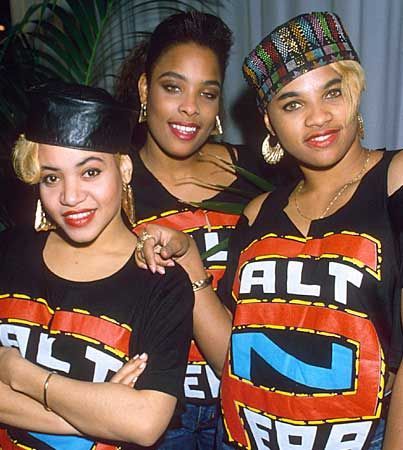
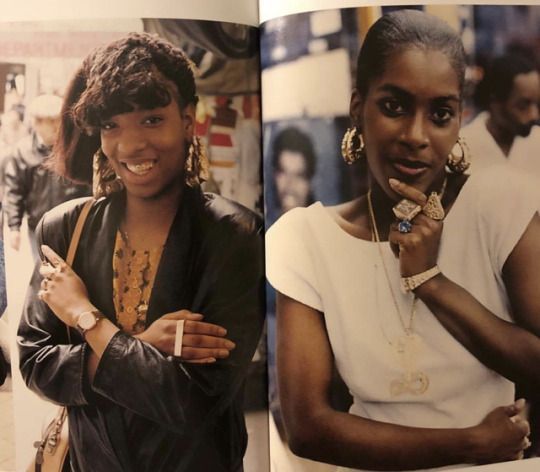
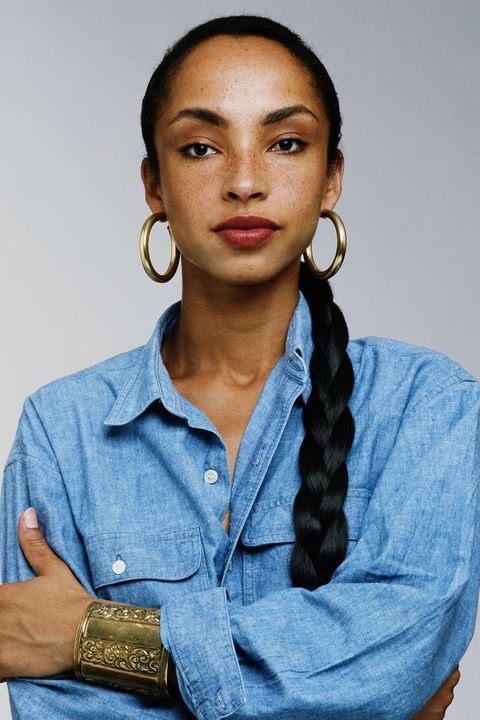
Now these earrings are a trendy layering piece, that are worn for a “sophisticated yet fashion-forward” look and cost upwards of $30.
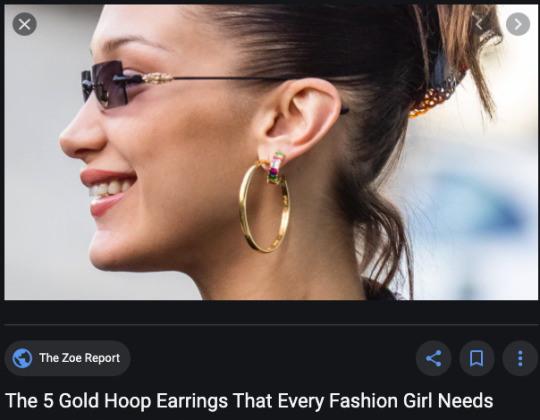
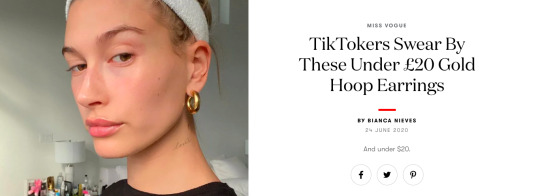
Baggy Pants & Flannels, or “Little Shirt Big Pants”
Dickies coming back were something no one could have predicted – these inexpensive “work pants” were normally associated and reserved for working-class individuals (who are always disproportionately people of color). However, Latina women flipped these baggy pants and jeans into part of their daily fashion, in a subculture known as Chola culture. This aesthetic was notoriously associated with lower-class, gang-related activity – down to the flannels, thin eyebrows, dark eye makeup, moles, and over-lined lips.
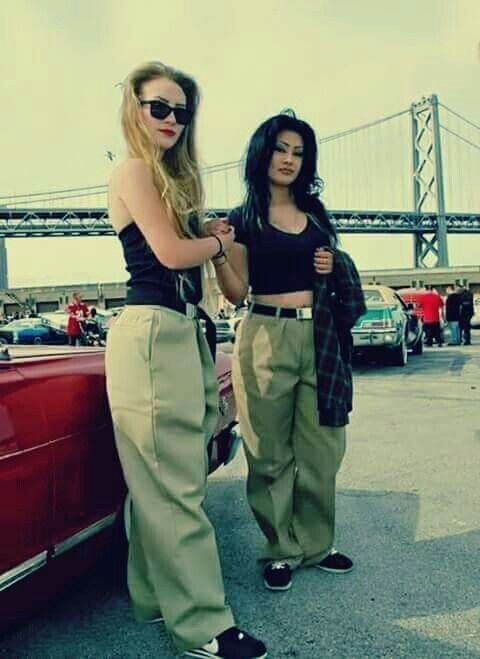
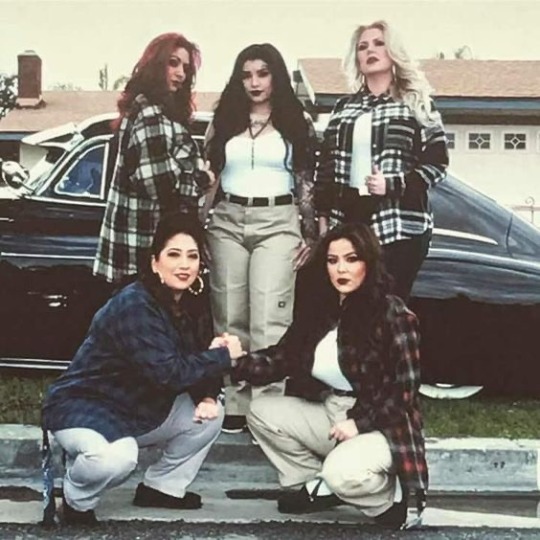
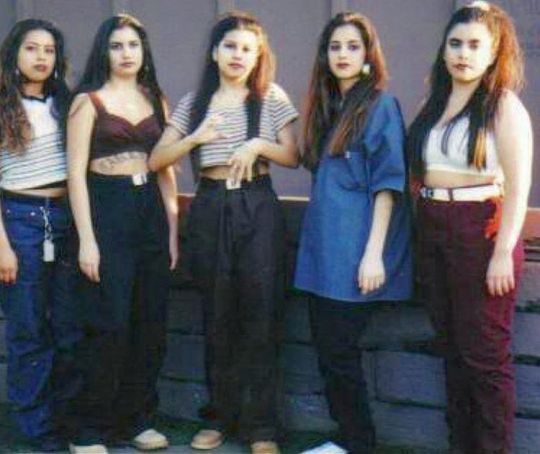
But as the early 2000s neared, a white pop-singer by the name of Gwen Stefani “introduced” (read: stole) chola culture to pop culture. Now, Chola culture has re-emerged as the Y2K aesthetic has become popular – and has even manifested itself into the “alt girl” aesthetics as well. The “little shirt big pants” trend has become associated with TikTok now as well.
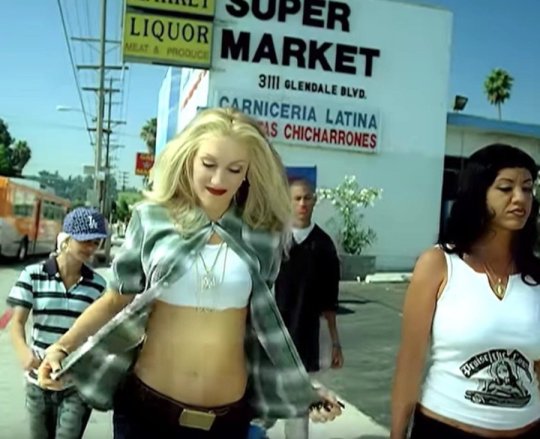
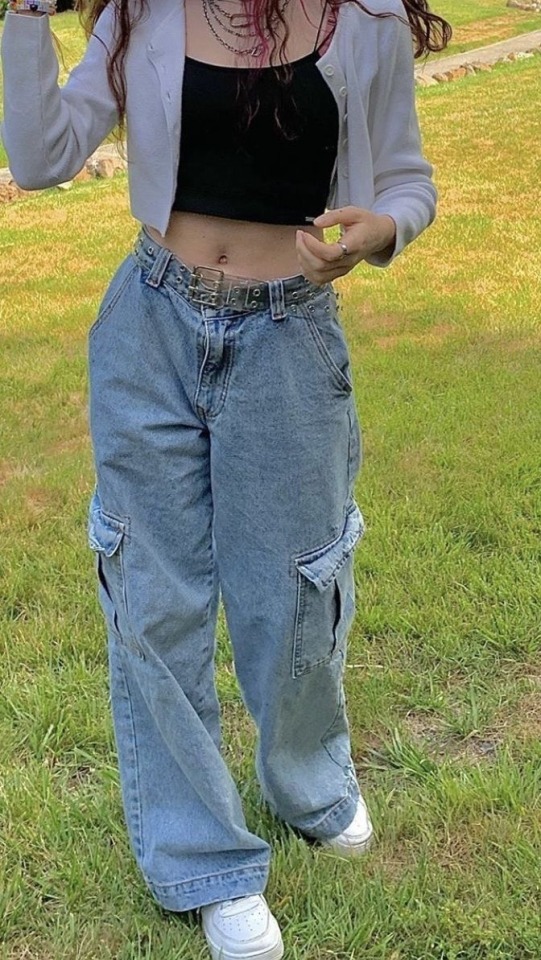
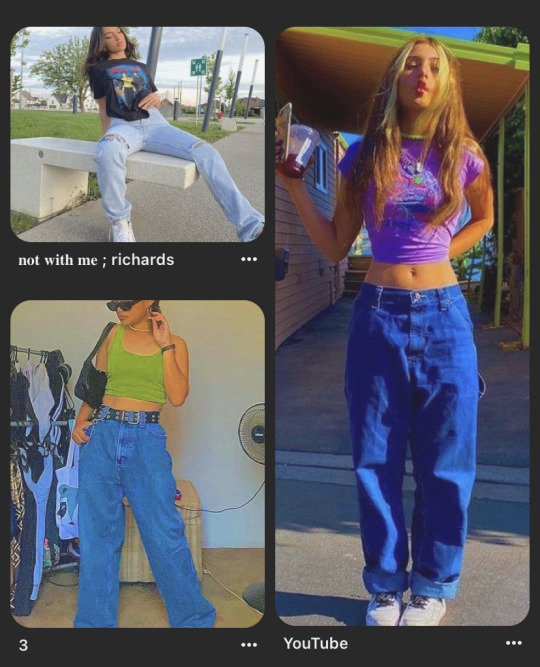
Hairstyles: Streaks, Ponytails, and Multiple-Parts
Hair is more than just hair for black women. Because of our kinky hair-texture, we are able to achieve almost any style – straight, curly, gelled, pixie, you name it. However, certain hairstyles are associated with negative stereotypes and were simply reserved for black women – white women, at one point in time, wanted nothing to do with black style and fashion. But in the 90s and 2000s as black female figures such as Alicia Keys, Tyra Banks, Lil Kim, Destiny’s Child, TLC (the list goes on) pushed themselves into the same rooms as their white counterparts, Rnb and Hip Hop became viable to white audiences. Anything “urban” was now fair game. The colorful streaks and highlights that artists such as Beyoncé and Lil Kim donned had their origins in the beauty salons in their predominantly-black neighborhoods (Houston, Brooklyn). Not to mention, colorful hair was reserved for black women due to the association of colorful wigs and extensions as “ghetto”.
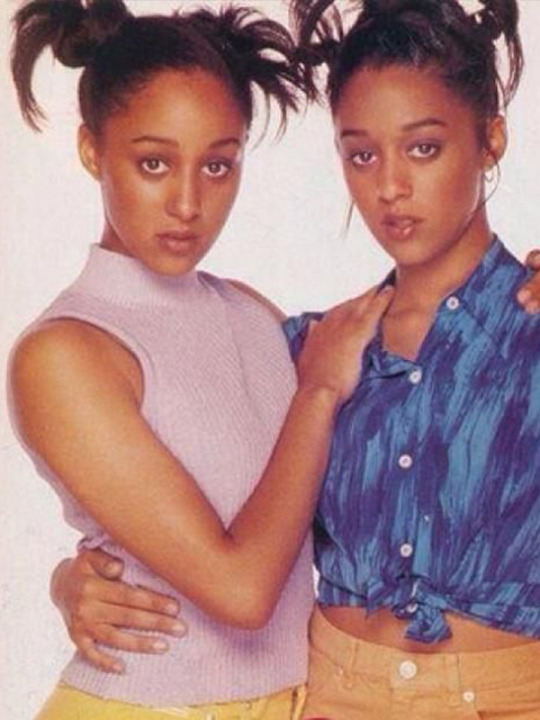
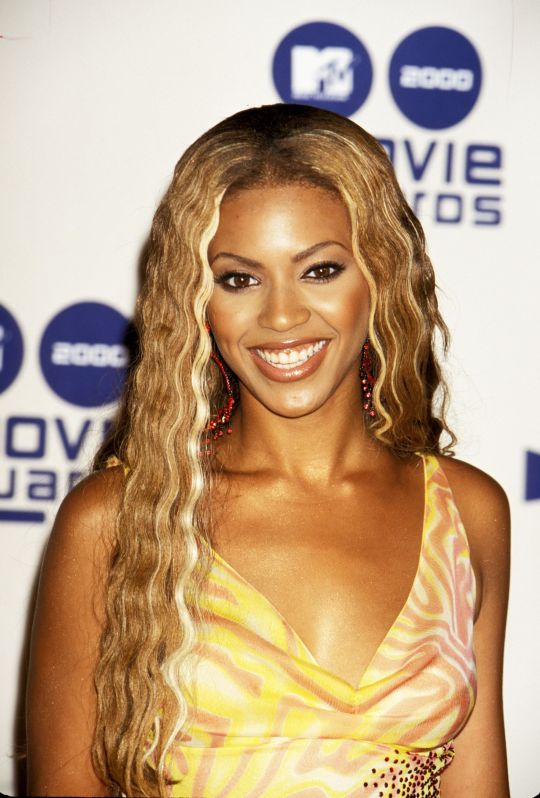
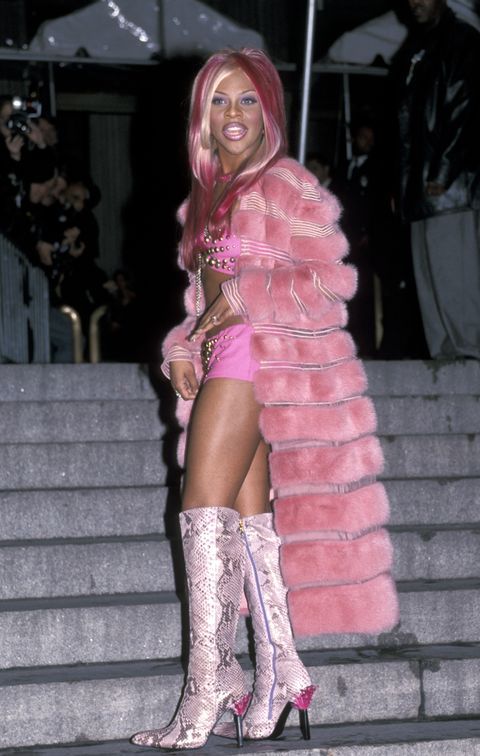
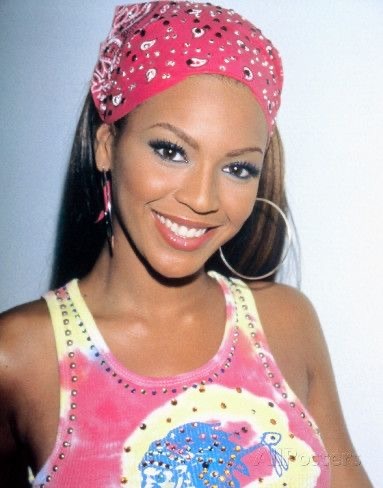
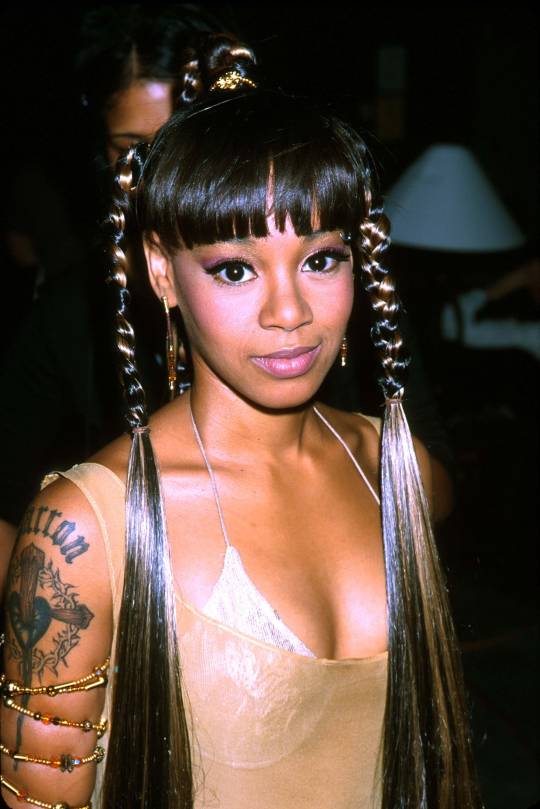
Both the colorful wigs and hair-streak trends were then adopted by pop artists such as Christina Aguilera, and have returned now as an homage to to 2000s artists – but not the originators. High ponytails with dramatic swoops, ponytails into braids, and bandana styles are included in the list of newly-popular “Tik Tok hairstyles”.
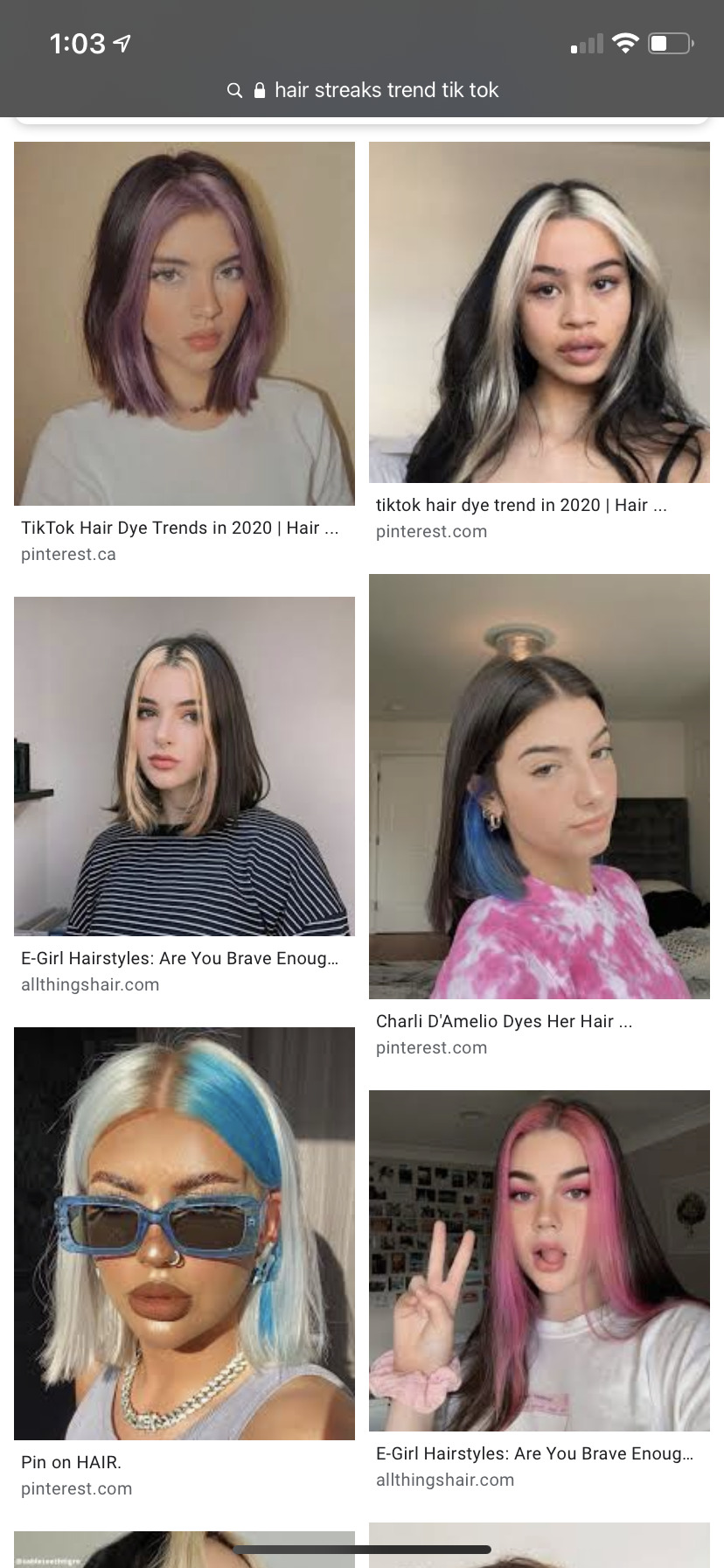
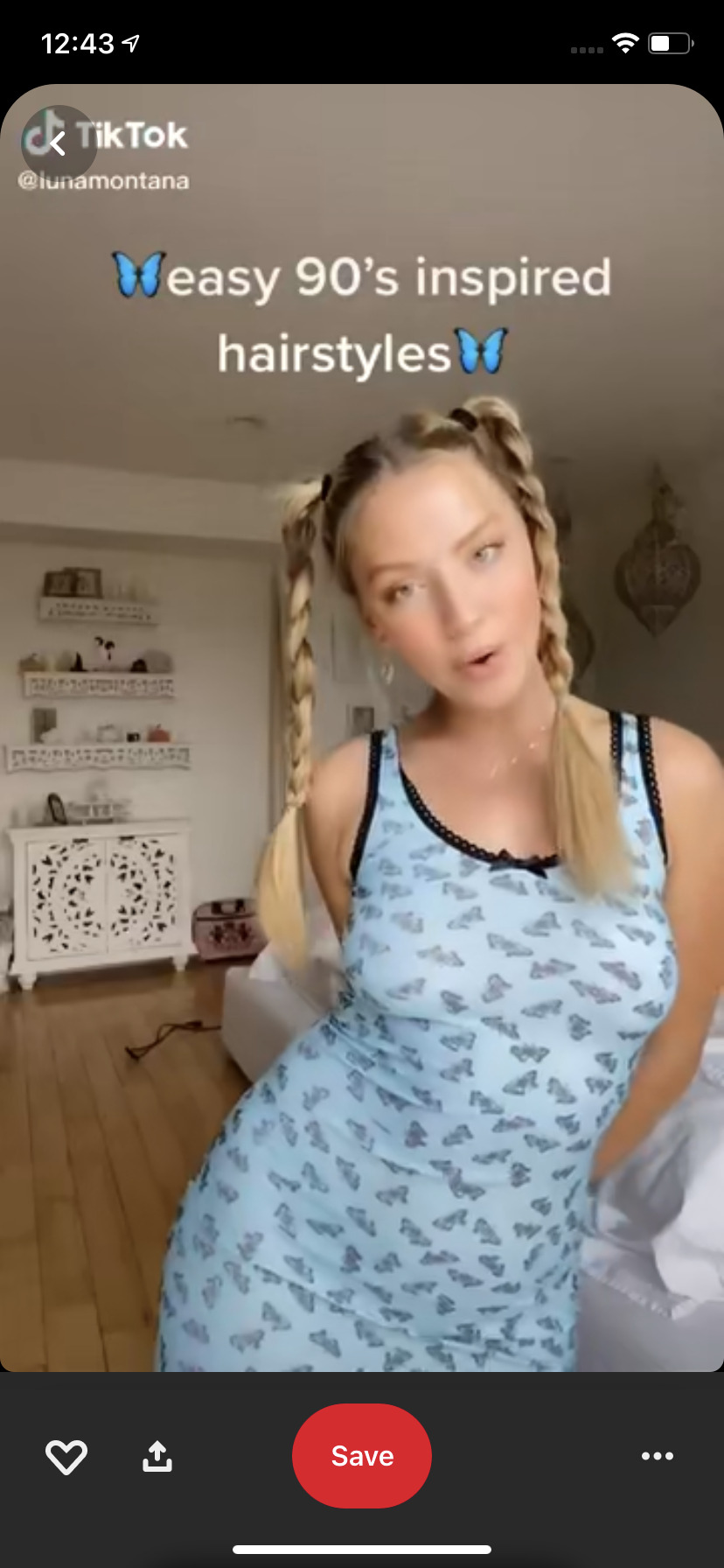
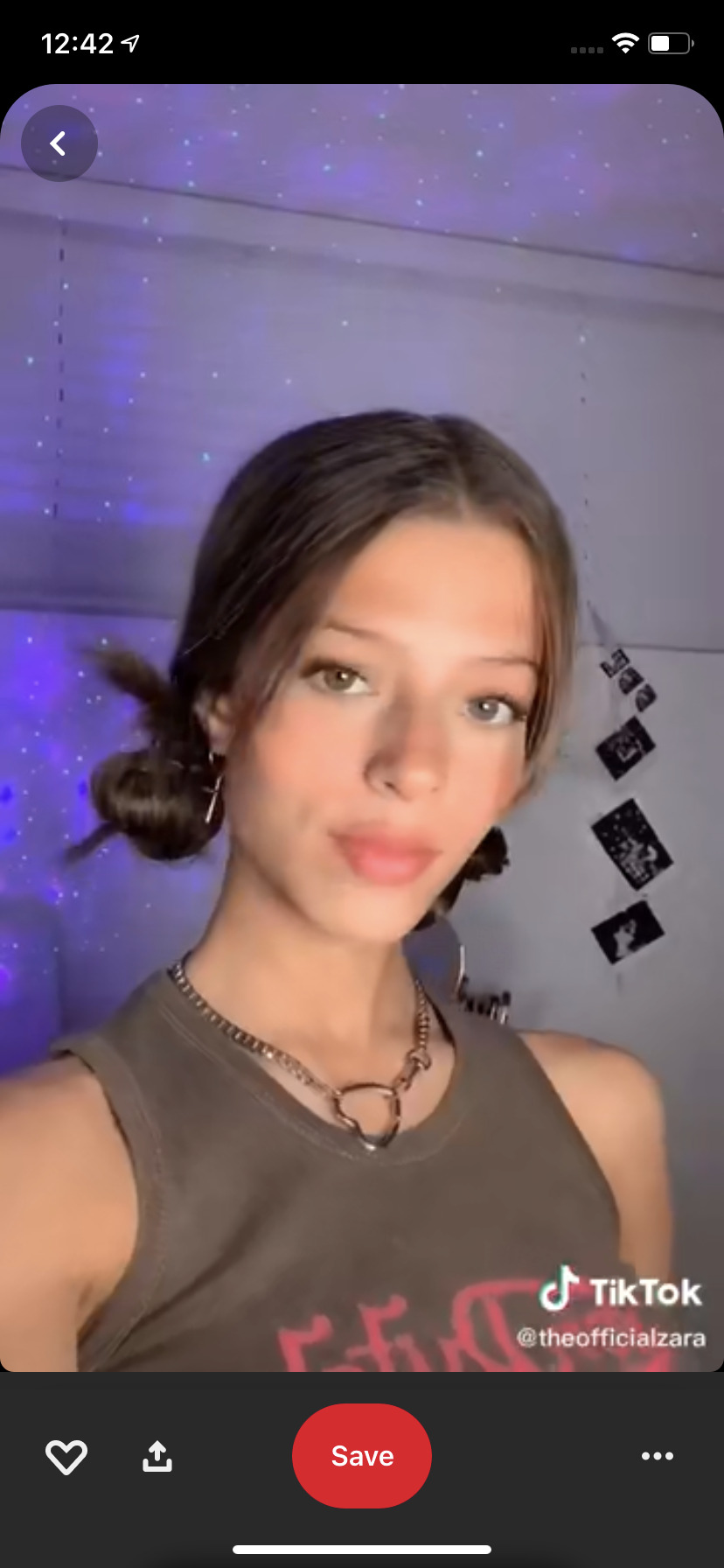
Low rise jeans, sequins, and all
Sequins were a particularly “2000s” fashion trend – a pair with low-rise jeans with a small, brightly-colored or sequined top was a staple for black and Latino artists on the red carpet.
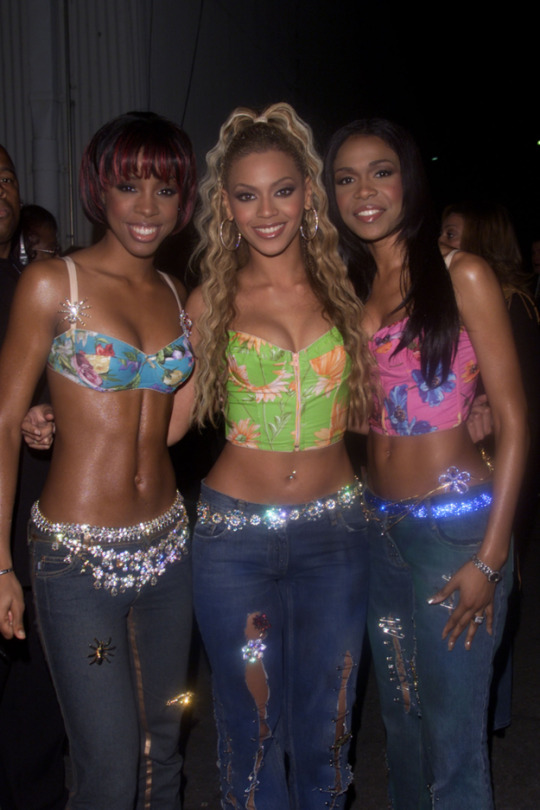
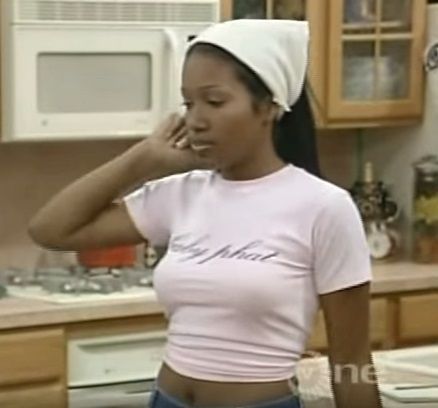
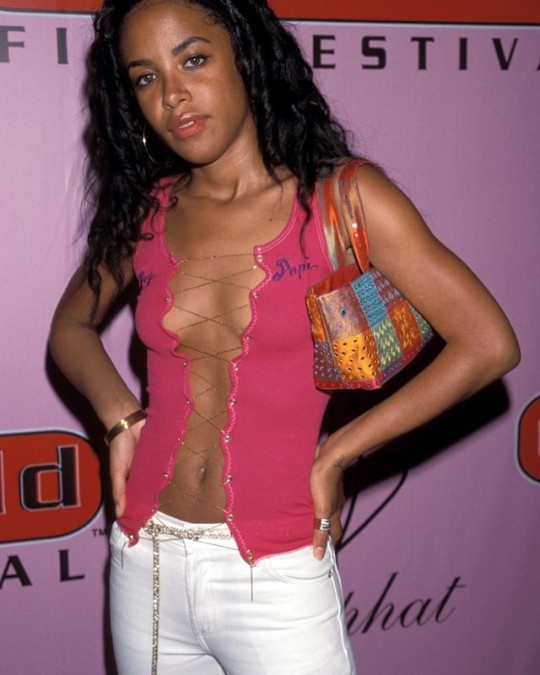
Even Aaliyah’s famous open-front zigzag top has been replicated down to the T for Summer 2020. Kimora Lee Simmons’ Baby Phat has come back as of 2019, as well.
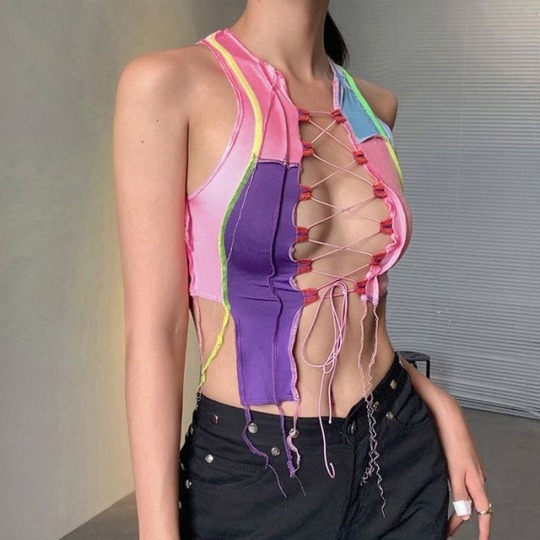

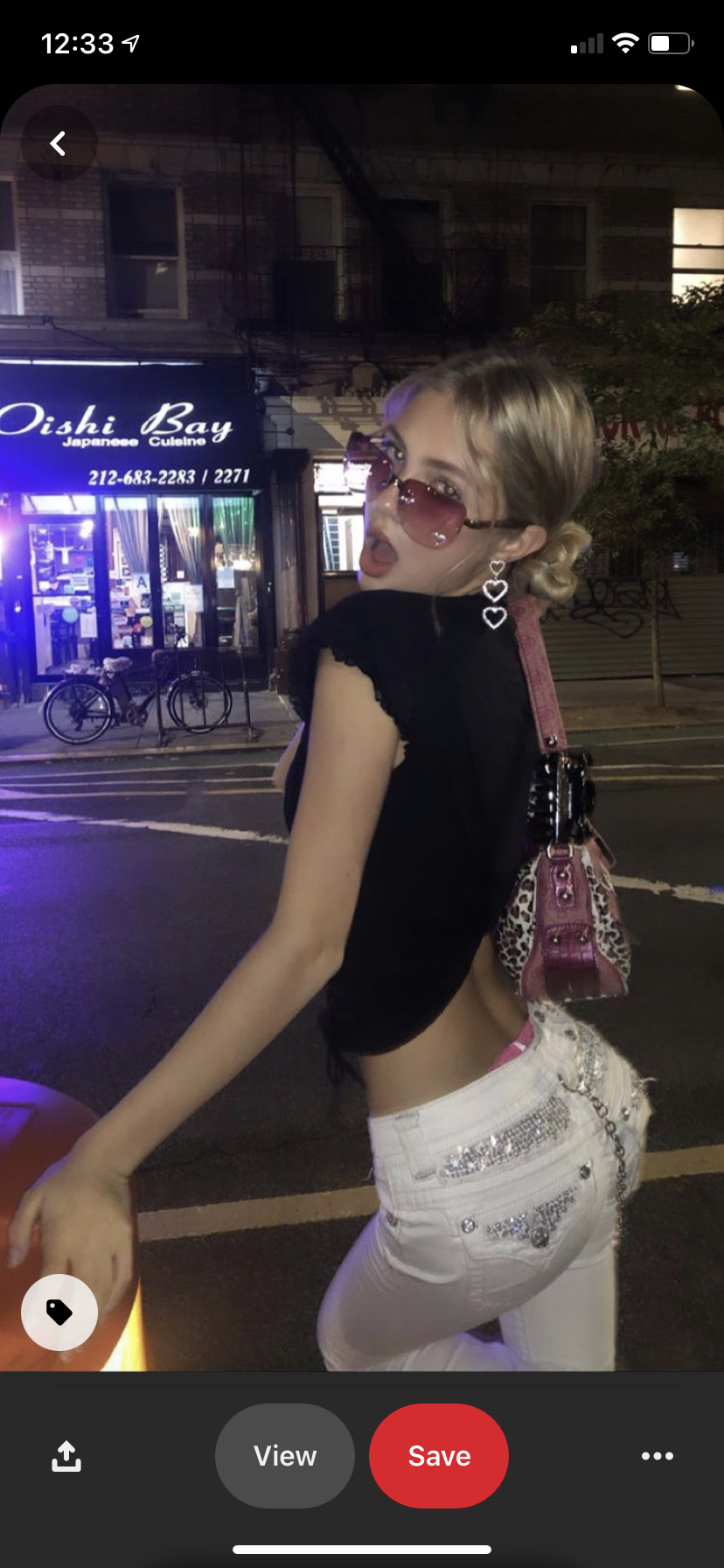
Logomania
Last but certainly not least, Logomania. Now this was another style that I could have never seen coming back, especially in the prestige with which it has. Having any piece of logomania clothing was a notoriously ghetto-fab statement – Lil Kim iconic outfits were just a reflection of what her community in BedStuy wore. Moschino, LV, and Gucci-patterened items were reserved for those who wanted to “show off” their designer items with flare, while traditional, subtle luxury wear was reserved for the “real” higher ups – until now.
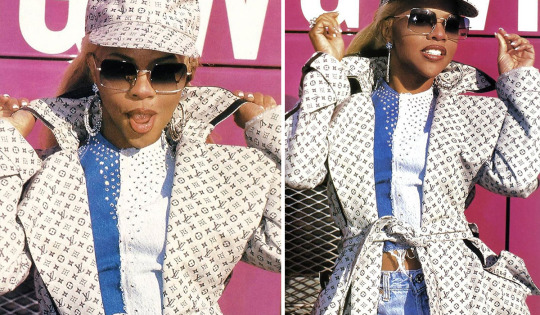
Billie Eilish is just one of many celebrities who have re-popularized this once controversial fashion statement.
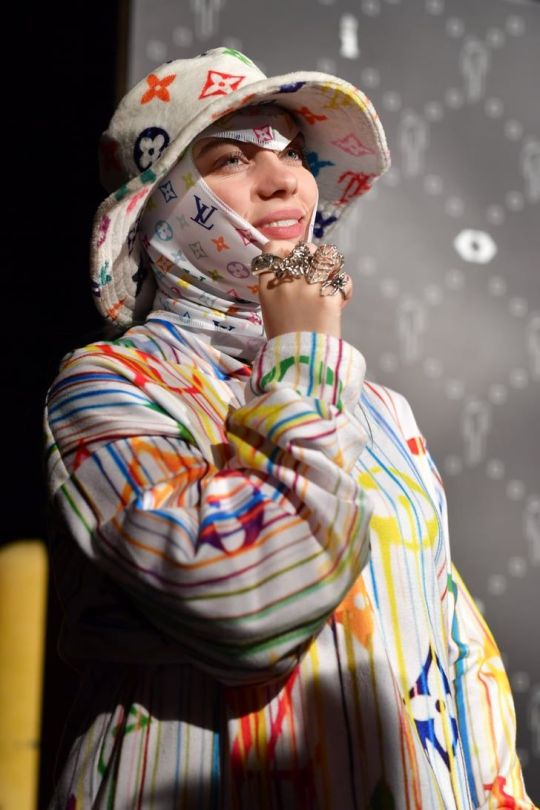
56 notes
·
View notes
Photo

We’ve Got A File On You: Win Butler
In a year when a lot of our plans have been on hold, Win Butler has been busy. In April, the Arcade Fire ringleader let us know that the band had been working on music shortly before lockdown, and then he let us hear some of it. Last week, on the night of the election, the band debuted a new song called “Generation A.” Apparently, Butler was one of the people who found quarantine more inspiring than suffocating. Just a couple weeks ago, he amended his previous hints with the update that he’s written “two or three” Arcade Fire albums thanks to having to stay still all year long.
It seems like there’ll be a whole lot of new Arcade Fire goings-on to parse sometime on the horizon, but that isn’t the reason Butler and I got on the phone one recent October afternoon. Butler’s not quite ready to talk about forthcoming music yet, aside from saying this era of writing gives him flashbacks to that which preceded The Suburbs and promising “The new shit is about some of the best shit we’ve ever done” as we say goodbye.
In the meantime, there have been some milestones this year: The Suburbs turned 10; Butler turned 40. There is, of course, a whole lot of rich Arcade Fire history between their early ’00s origins and now. There are too many high-profile collabs to dig through, too many pop culture crossovers to cover, in just one conversation. But before Arcade Fire’s next chapter begins, while we both had a moment of quiet at home in the year 2020, Butler and I took some time to dig back through highlights and surprises from across his career.
Appearing In Bill & Ted Face The Music (2020)
How did this happen?
WIN BUTLER: They were filming in New Orleans. I’m kind of the exact age where Bill & Ted really has a soft spot in my worldview. [Laughs] That was just like, yeah, of course I want to be in the Future Council. That’s the part I was born to play. No, it’s funny, it was just one of these random things that come through the email. Usually, it’s, “Nope, nope, nope, nope.” But this was, “Tell me when, tell me where, I’ll be there.” It was on soundstages. When we were filming it, Tommy Lee from Mötley Crüe was back there, and he sort of disappeared at some point. I got to bring my son, who’s six. He was hanging out and we were talking to Keanu about Canada and punk bands back in the day. It was a pretty sweet hang. It was a bright spot in 2020, let me put it that way.
You say you get these emails — is that random stuff they want Arcade Fire to do, or there’ve been other cameos you turned down?
BUTLER: Oh, no, it’s mostly random licensing or stuff that goes to the junk box. But every once in a while, it’s like, “Hey, that sounds like a nice way to spend the day.” I started out in film. I went to Sarah Lawrence College in New York around 2000. I had really wanted to go to film school, and I could never get in. [Laughs] Initially, the song “The Suburbs” was an idea I had for a film and it seemed easier to make a song than a film.
The Suburbs (2010)
That was a convenient segue. The Suburbs just turned 10. I was wondering if you have gone back and revisited it much amidst that anniversary.
BUTLER: The whole experience of Funeral was such a rollercoaster. We were on the road so long. We didn’t have much of a break going into the second record. For The Suburbs, Régine and I — I don’t think we saw anyone for a year straight before we even started demoing or anything for that record.
It was a time in my life… I don’t know, I was in my late twenties, and there were all these details of my childhood in Houston. You know, I moved to Canada when I was 19. [Houston] almost felt like this other life I had. I would close my eyes and imagine riding my bike through town and trying to find the edges of my memory. There was kind of all this emotion that came up through that, and I wanted to capture it. It’s funny, as a songwriter, most of the time I feel like my mind is living in the near future. You’re listening for these little signals in the air. This was almost inhabiting the emotional space of these memories but thinking about it as the future.
When you say it like that, I’m curious if the album feels different to you now that you’re a father yourself and another 10 years down the line. Like another layer to that refracted youth, sort of?
BUTLER: Totally. In a way, I feel like the last year has been a parallel to that year before The Suburbs. Then I was kind of a hermit by choice, and this has more been the world conspiring to make me a hermit, but it has been a really introspective. In a sense, the material that we’ve been working on feels the same way, this hybrid of your emotional landscape and the future.
It’s almost seasonal, like a trade wind that blows in once in a while. I remember we played with Neil Young when he was still doing the Bridge School Benefit and hearing him sing “Old Man” as an old man, almost like he wrote the song when he was 22 to sing when he was 80. I think there’s an element on that Suburbs record that’s like that as well.
Winning The Grammy For Album Of The Year (2011)
Obviously that was a huge turning point for Arcade Fire because you won the Grammy the following year. As a suburban indie fan at the time, I had no real grasp on how big certain bands were. From where I was, it was pretty trippy that you guys won that.
BUTLER: I mean, tell me about it. It was definitely pretty trippy.
There are very, very early moments of you guys getting linked up with some iconic artists. Arcade Fire got plenty of respect from the beginning. But at the same time, the Grammys is something different. That’s a moment of mainstream insurgency. Ten years on, you’re one of the big indie bands of your generation, but also one of the only rock bands to get to that level in recent times.
BUTLER: I don’t know it was the best record that year, but it was definitely the best record nominated that year. I mean, we were up against a Lady Gaga remix record and like, Katy Perry. We weren’t up against a great Eminem record, we were up against a not-that-great Eminem record. In a certain sense, I was like, “Well, I think we should win.” [Laughs] I think we had the best record.
I remember in high school Radiohead and Björk were the two [new artists I loved]. I bought The Bends the day it came out, I bought Homogenic the day it came out. And then everything else I listened to was artists that had broken up 20 years earlier. I remember watching the Grammys the year OK Computer was nominated and it didn’t win, and I was just like, “Oh, that thing must not mean anything then.” I remember Dylan won, and it’s a really great Dylan record, but objectively OK Computer was the best record. So if that didn’t win, then what the hell does that thing mean? After that, I didn’t think about the Grammys that much. It wasn’t on my list of my dreams of my career and what I could accomplish and what I wanted to do.
For me, I was looking more at a band like the Cure or New Order, these bands that were really just artistic entities but you would hear them at a pharmacy once in a while. Like, I’d hear “Bizarre Love Triangle” come on in the pharmacy in Houston and just be like, “Is this from outer space? What the fuck is this?” My dreams for our band was to do for other people what those bands did for me, which was just throw me a fucking lifeline. Because I was just like, “What is this world, and where are my people, and how can I feel OK existing?” My grandfather played in big bands and played with Louis Armstrong, and he bought me a guitar when I was 15. I held on to that thing — if I didn’t have that I don’t think I would’ve made it out of high school. It literally saved my life. I don’t think I could exist without that.
For me, the Grammy thing was strangely moving. Even up until the moment we won, I just felt like an interloper. Even when we won, people looked at us like aliens. Like, “Who? What?” You know, I’m a competitive person. It was really exciting. Cool, awesome, the universe makes sense for one second. It’s interesting, I didn’t expect it to mean anything until we won, and then it meant something.
David Bowie (2005, 2013, Throughout)
I alluded to this earlier but: The Grammys were like an industry stamp of approval. From the beginning, however, you guys were embraced by a lot of elder artists — particularly artists who were influences on the band. One I wanted to talk about was David Bowie. He was a very early supporter; you performed together in 2005, which turned into a live EP. Then he shows up on “Reflektor” in 2013. Somewhere around 2015, you talked about how you’d come to regard him as this professor-type character in your life. He came to your first New York show, right?
BUTLER: Our first headlining show, when we played at the Bowery, Bowie and David Byrne came to that show.
Wow, no pressure huh.
BUTLER: It sort of set the table. Like, “Well, I guess this is how it’s going to be right out of the gate.” [Laughs] It’s funny, I have a photo of David in my studio that I look at when I’m working sometimes. It’s just him in a dressing room with one of those kind of Hollywood mirrors behind him. He really… I don’t know, he felt some sort of spiritual connection with us. It wasn’t like he wanted anything from us. I just think he wanted to say, “Hey guys, you’re going on the right path, keep going.”
I was emailing him over all those years. I don’t know if you have anyone close to you that’s died and you go back and read those emails, it’s really these strange digital fragments of someone you care about. After he sang on “Reflektor,” Régine and I bought him a painting in Haiti as a thank you gift. We were supposed to mail it to him and we got busy and forgot about it, and in the interim he passed. I knew he wasn’t well, but I didn’t know he was dying. Maybe a couple months later I remembered the painting and I dug it out and it was a painting of a black star. A voodoo painting of a black star with rays coming out of it.
I didn’t know anything about his record being Blackstar or anything like that. Now it’s on the wall of my bedroom. Shit like that sometimes happens in my life. I take it for what it is. I don’t know exactly what that means and I just feel grateful… I don’t know man. Even just how inspiring, what he put into his art even in death. He’s someone I think about at least on a weekly basis.
Backing Up Mick Jagger On SNL (2012), Playing With The Rolling Stones (2013)
Obviously that was an ongoing relationship, and you’ve worked with David Byrne too, and you referenced playing with Neil Young. Still: Being onstage with the Rolling Stones seems particularly daunting.
BUTLER: We were Mick’s backing band on SNL. SNL is maybe one of my favorite American institutions. I don’t know if it’s the Canadian thing since Lorne [Michaels] is Canadian. The first time we did it, it was just like, “This dude is my friend.” I don’t know if Lorne’s kids like Arcade Fire or something. But I was in New York randomly and he was like, “Mick’s doing a thing,” and I said, “We do a pretty amazing cover of ‘The Last Time,’” and he said “Come on down, let’s do it.” Then we’re Mick’s backing band. I don’t know, pretty fucking cool.
What is Mick Jagger like to work with?
BUTLER: Mick is like: As soon as the light goes on, he’s a different person. When he turns it on, it’s like this muscle memory — like if you were with the greatest ballet dancer ever, and you say go and this energy comes out of him that is so practiced. It’s someone who’s an absolute master, after practicing something for decades and decades and decades. That was pretty amazing to see. You’re chatting with someone, we’re at the piano and we’re talking about an arrangement, “OK, let’s do a run,” and then, “Boom! Shit!” There he is.
It’s this other level. I feel like people at that level, music’s not something they’re fucking around with. [Laughs] Music is a spirit. You hear something, and if it strikes a chord with you, it connects something at your deepest core. People like that, when you see them do their thing, it really is this other plane. It’s not this show thing. It’s more of a possession. You can hear it in the music.
I feel like I’ve listened to more music during COVID than any time since I was like, 18. I had this moment when I was listening to these amazing records from the 1950s. You can hear the room. It’s almost like audio VR — you can hear the drummer here and the bass player over here. There’s a sense of space, particularly to that older music. It’s a snapshot. If you hear “La Bamba,” right now, that is what it is. It’s a spirit captured on vinyl, on a piece of tape. It’s alive within that.
With people like Mick, they’re a little bit closer to the spirit of rock ’n’ roll — a literal spirit, not a figurative spirit. Bowie was the same. When he played with us in Central Park, the second he hit the stage he’s illuminated. You’re like, “Oh, shit, that’s what it is.” He’s a human when you’re talking to him and as soon as he’s in it, he’s touched by another thing.
SNL (2007-Present)
I’m glad you brought SNL up, because you’ve been on it a bunch of times, but you’re also one of the musical acts they’ve brought into skits. Like, they actually wrote a game show around you. How does that work? Did they write that sketch with you guys, or you walked in and they’re like, “Hey, by the way…”
BUTLER: I can’t remember, I think we’ve been six or seven times. We’ve been there for a couple different casts at this point. The Lonely Island dudes, those are so my dudes. In another life, I would’ve been in Lonely Island, that would’ve been my dream to just fuck around with my friends; when we were first writing music we were kinda joking around because you’re too insecure to try. A lot of times [at SNL], we’ve played for the staff when we’re there, because you get so fired up to play one or two songs and you’re playing live so your endorphins are running so we just sort of keep playing afterwards. I feel like they appreciate that, it kinda feels like you’re on the same team or something.
I was backstage at SNL once last year, and it is pretty crazy to see it all from the inside like that.
BUTLER: It’s so crazy. They write it all that fucking week, and then to see the differences between the dress rehearsal and the live show. They do a little meeting in Lorne’s office. They’ve done the dress rehearsal and it’s still this tiny office and every cameraman and every cast member is crammed in this little office and Lorne’s like, “Make it a blue light instead of a green light at minute 23, and change this word to this word, I don’t think that’s funny, change that, OK, go,” and everyone’s got pencils writing this down. It’s still fucking that. And you know, it hits and misses sometimes, but they’re doing it.
How long did you have to work on your De Niro impression for that skit?
BUTLER: It’s actually more of a Billy Baldwin impersonation, but it seemed to work for De Niro as well. [Laughs] My only real impression is I can look exactly like Billy Baldwin if I want to. If there’s any casting directors reading this and you need a Billy Baldwin impersonator, I’m your man.
LCD Soundsystem’s Goodbye Show (2011)
You’re the one who ended up serendipitously coining the title of the live album.
BUTLER: [Laughs] That is true. That was genuine. He was being a little talky.
I moved to New York before I moved to Montreal, and I would go to the city and go to shows and I didn’t see one fucking thing that was good in the whole year. I was like, “Wait, I thought New York was the shit, where is it?” All I saw was bad, very industry bands. I couldn’t find anything, I wasn’t cool enough to figure out what was going on. There’s very few bands that I really think of, like bands of my generation where I heard them and thought “These are my people.” For me it was the Yeah Yeah Yeahs, LCD, and Wolf Parade. When I heard those bands, I thought, “These are my fellow pilgrims.” It was art, DIY, no bullshit, just trying to make something great that communicates to people. It’s real and emotional.
James is really just one of us. He’s just such a great engineer and really into the way things sound and really passionate about details. It’s rare to meet people like that. James was working with us when Bowie came in, when we were in Electric Lady. James had never met Bowie before. The first 7” he ever bought was “Fame.” We’re in this studio, and the last time Bowie was there he had cut “Fame” with John Lennon, in the same studio. We were all like, “This is the right place to be.”
James is just a man after my own heart. We did a tour with them on Neon Bible. We were playing to a thousand people in Salt Like City and I was like, “Man, in a couple years a lot more people are going to wish they were at this show.” What a fucking great live band.
Scoring Her (2013)
What kind of headspace did you have to get into for this vs. making an album?
BUTLER: Spike [Jonze] came to a bunch of our early shows on Funeral. The second I met him he was just immediately one of my best friends. He thinks about the world the same way. Even though we work in different mediums he was someone I knew I’d be working with in some capacity. I was visiting LA and I was staying with Spike just randomly one time, in the early days of him working on the script for Her. I was reading the script and immediately thinking about how it could sound, and I was like, “Well, we should fucking do the score to this movie.”
When you’re working on a record, it’s so rigid, what works on a song and what doesn’t work on a song. It can be so limiting in a way. Within the band, there’s so many different talents and color palettes and things people bring to the table, so it was cool to do something where the boss is the picture. It doesn’t matter how anyone feels about a piece, if it’s working for Spike, if it’s working in harmony with the picture, that’s what the boss is — the emotionality of the picture. It’s not about you, it’s in service to this bigger thing. It was a cool opportunity for all of us to use different aspects of things we do, and to work with Owen [Pallett], who had done a lot of strings on our records. It uses a totally different part of your brain.
Do you want to do more of that kind of work, or was it this specific story from Spike that spoke to you?
BUTLER: I can say pretty confidently that I’ll work with Spike in the future. It definitely takes a lot of energy. It’s definitely something I’m interested in, but I feel like while I’ve got the juice it’s good to spend as much energy writing songs as we can. It’s pretty fucking hard to make a record, believe it or not.
Future’s “Might As Well” Sampling “Owl” From Her(2017)
Are you a big Future fan?
BUTLER: I love Future. There’s something in the rhythm of the thing he does that actually reminds me of some music from Haiti, in this really deep, subtle way I can’t put my finger on. There’s something almost mystical in the way he sounds, and I thought that was really cool that they sampled that soundtrack. His shit does sound like the future still. I think it’s pretty special.
The Reach Of ”Wake Up” (2004-Present)
This song has had this big pop-culture reach over the years. U2 used it as their walk-on music in the ‘00s. It was used in the trailer for another Spike movie, Where The Wild Things Are. Macy Gray and John Legend both covered it. Microsoft ripped it off for a commercial. It was used in a commercial for LA’s bid for the Olympics.
BUTLER: That Microsoft money went to Haiti, by the way. They did rip it off. [Laughs] Thank you Microsoft.
As far as I know that’s far from an exhaustive list, too. It’s just one of those songs that’s gone out and become a part of the atmosphere. Even a lot of big bands don’t necessarily have a song like that. What do you think it is about “Wake Up” that’s registered in so many different contexts?
BUTLER: From the time we wrote that song to now, the biggest difference in my life is I’ve traveled the world and I’ve been able to play music in all these different cultures and feel the ways different countries feel music. Not only listening to the music in other countries but seeing how they feel the music I play.
I remember around The Suburbs we played in rural Haiti. It was our first time playing in a place where nobody in the audience had any of the reference points of the music we played. We were playing in the mountains, there were people walking in barefoot to the concert. We were playing these songs we had been touring the world with, and the energy from the crowd was so different. The things they responded to, the things they felt, it actually fundamentally changed the way I heard my own music. It made me start to think about music not just from my own perspective but culturally how people hear it and feel it.
I think the one thing that kind of transcends everything across all cultures is melody. Régine was playing that melody on piano in our rehearsal room. I hear it like it was yesterday. It was like, “That’s the shit.” [Laughs] Being present and being in the room, hearing something and really giving yourself to it, just singing that shit like it really meant it and feeling the power of that melody and trying to push it until it breaks. That’s something I think about, just how great it is to have people to play music with. To say it like you mean it.
I remember singing that song in Montreal, in these lofts. Most of our early fans, the first time we played that song, they were like “Fuck this shit, I want the acoustic shit.” People were so negative. I remember a lot of early fans didn’t come to our shows after that because we were suddenly screaming at the top of our lungs and playing electric guitars. It was like, “Everyone here hates this, that means we must be going in the right direction.” [Laughs] But yeah, don’t be discouraged if people hate something. It doesn’t mean shit.
https://www.stereogum.com/2105395/win-butler-interview-spike-jonze-arcade-fire-snl-mick-jagger-david-bowie/interviews/weve-got-a-file-on-you/
52 notes
·
View notes
Text
“Literal violence” and the death of the heterodox

I teach college students. This means I assign young people things to read. If the students don’t do the reading--if they consider it too boring or uninteresting or difficult--they don’t do well in the class. I update my reading lists every semester, because what was interesting to students a few years or even months ago might not click with the students of today. Sometimes students love what they’re assigned. Sometimes they hate it. And it’s very hard to tell if a piece is or isn’t going to work until I’ve assigned it and gotten feedback.
As I’ve gotten older it has become more difficult to relate to young people. This is a completely normal part of life--nothing to be ashamed of or panic about, and I think almost everyone agrees that it’s more dignified to age gracefully than to try too hard to seem hip or with it. And so, over the past few years, as I’ve found it nearly impossible to find good, engaging writing with a broad appeal, I figured it was just because I, naturally, don’t relate to young people as much as I used to.
But lately--certainly since Trump’s ascendance, but perhaps going back as far as the early twenty-teens--mainstream writing has become incredibly predictable. Name any event and I can tell you almost word-for-word how it will be discussed in Jezebel vs. Teen Vogue vs. The Root vs The Intercept. And, increasingly, there’s been very little analytical divergence even between different publications. Everyone to the left of Fox News seems to agree upon just about everything, and all analysis has been boiled down to the repetition of one of a half-dozen or so aphorisms about privilege or validity. There is, in short, a proper and improper way to describe and understand anything that happens, and a writer is simply not going to get published if they have an improper understanding of the world.
This, I think, is the result of our normalizing hyperbolic overstatements of harm and the danger posed by anything short of absolute fealty to orthodox liberalism. If it’s “literal violence” to express mild criticism and incredulity, people aren’t going to do so. Editors don’t want to risk accusations of “platforming fascists,” and so there’s been very little pushback against fascism being recently re-defined as “anything that displeases upper middle class Democrats.”
Not long ago, it was commonplace on the left to celebrate the internet’s ability to allow writers to bypass the gatekeeping functions of old media. With mainstream liberalism needing a scapegoat to explain away the failures of the post-2008 Democratic party, however, the tone has shifted.
Case in point, Clio Chang’s rather chilling piece from the Columbia Journalism Review that seeks to problematize an open platform called Substack.. Substack allows writers to publish almost whatever they want, outside of editorial control, and then charge a subscription to readers. As more and more websites and print media are being hollowed out and sacrificed to the gods of speculative capital, a large number of big-name writers have embraced this new platform. It has also allowed writers to report on stories that are objectively true but inconvenient to the Democratic establishment, such as Matt Taibbi’s admirable work debunking Russiagate bullshit.
Chang begins with a lengthy description of Substack’s creation. She stresses that no one—not even the site’s founders and most successful writers—consider it an ideal replacement for the well-funded journalism of old. Chang focuses on one particular Substack newsletter called “Coronavirus News For Black Folks” which appears to be moderately successful (the piece cites 2000+ subscribers, and its founder is earning enough to have hired an assistant editor). Even after describing how the platform has given large grants and stipends to other newsletter run by women and people of color, the fact that this one particular newsletter isn’t as successful as others is held up as proof of the platform’s malignancy.
“Coronavirus News For Black Folks” may be somewhat successful, but Chang implies that it rightfully should be even more successful, and that something evil must be afoot. Simple arithmetic tells us that a specialized newsletter—one pitched specifically to a minority audience and only covering one particular issue—is going to have a smaller readership than a more general interest piece. Rather than accept this simple explanation, Chang instead embraces the liberal tendency to blame a lack of desired outcomes upon the presence of evil forces.
While Chang provides a thorough overview of the current, fucked state of media and journalism, at no point does she grapple with the role that mainstream liberalism has played in abetting the industry’s collapse. This is surprising, as a quick google search suggests she generally has solid, left-wing politics. This omission reveals a problematic gap in left analysis, and bodes poorly for any hope of leftism accomplishing any material goals while the movement remains aligned with more mainstream identity politics. Even as she cogently explains the destruction of media and the hellish future that lay before writers, Chang still embraces the mystical fatalism that liberals have been leaning on since 2010 or so, when it became clear that Obama wasn’t going to make good on any promises of hope or change. She blames our nation’s horrors not elite leadership, but on the presence of people and ideas she doesn’t like. In this case, Substack is problematic because many of its writers are white and male, and some are even conservative:
When [Andrew] Sullivan joined Substack, over the summer, he put the company’s positioning to the test: infamous for publishing excerpts from The Bell Curve, a book that promotes bigoted race “science,” Sullivan would now produce the Weekly Dish, a political newsletter. (Substack’s content guidelines draw a line at hate speech.) Sullivan’s Substack quickly rose to become the fifth-most-read among paid subscriptions—he claimed that his income had risen from less than $200,000 at New York magazine to $500,000. When I asked the founders if they thought his presence might discourage other writers from joining, they gave me a pat reply. “We’re not a media company,” Best said. “If somebody joins the company and expects us to have an editorial position and be rigorously enforcing some ideological line, this is probably not the company they wanted to join in the first place.”
I’m no fan of Andrew Sullivan, but the man has spent decades building and maintaining his audience. Of course he’s going to have a larger readership than someone who is just starting out. This isn’t a sign of anything nefarious. It’s basic commonsense. But there’s no other conclusions that can be reached: things are bad because people haven’t done enough to root out badness. Things are bad because evil exists. The only way we can attempt reform is to make the evil people go away. Anyone who says anything I don’t like is evil and their words are evil and they shouldn’t be published.
Chang doesn’t make any direct suggestions for remediating Substack, but her implications are clear: equity requires censorship and ideological conformity. Providing any platform for people who are disliked by the liberal mainstream, be they too far left or too indelicate with their conservative cruelty, equates to harming vulnerable people—even when those vulnerable people freely admit to making money off the same platform. There is no room for dissent. There is no possibility of reform. The boundaries of acceptable discourse must grow narrower and narrower. Only when we free our world from the presence of the bad ones will change magically arrive.
NOTE: I wrote a follow-up to this piece that I think does a better job of articulating the points I was trying to make.
28 notes
·
View notes